Tessa’s Recipe Rundown
Taste: Buttery pie perfection.
Texture: Oh-so flaky and wonderfully tender.
Ease: I break down each step, so there’s no need to be intimidated!
Why You’ll Love This Recipe: All my best tips and tricks, plus the perfect ratios of each simple ingredient, for the best pie crust ever.
This post may contain affiliate links. Read our disclosure policy.
Homemade pie crusts are about a thousand times more flavorful, flaky, and tender than the store-bought kind. It takes a little bit of extra work to get a perfect pie crust, but it absolutely does not need to be as intimidating as it may seem.
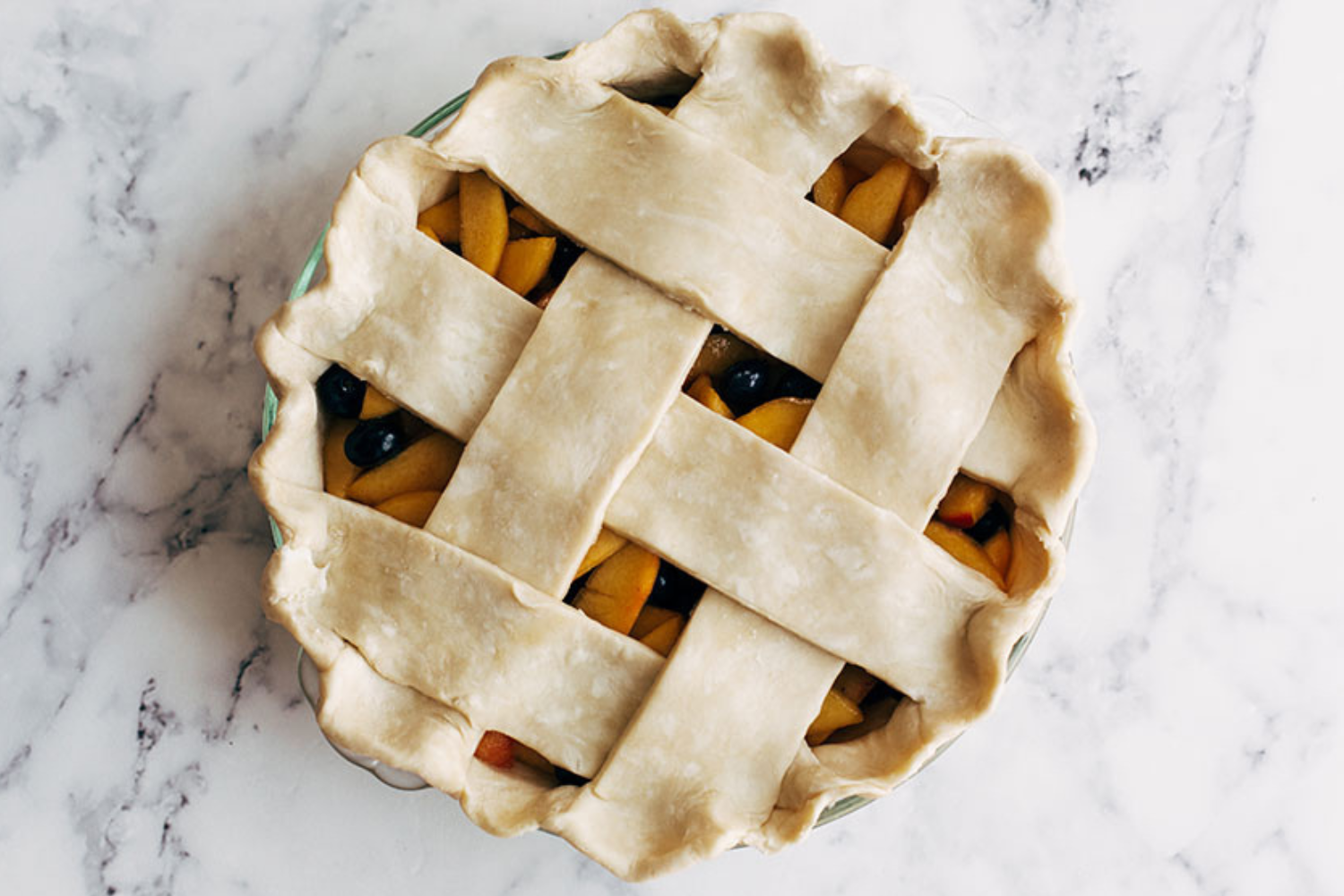
Until the dough comes together in a cohesive ball, it seems like something has gone wrong. Not to mention all of the frustrations when pie dough shrinks or loses its shape after baking. I’ve factored in as many potential pie crust woes into this recipe to make it as foolproof as possible.
I actually completely overhauled my pie crust recipe in 2020 to make it even more tender and flaky. I took a bunch of feedback I’d received over the years from readers to improve the recipe and I’m so happy with the results! Take a look at just how flaky:
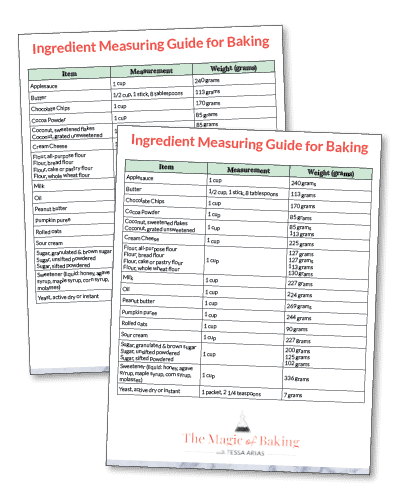
Free Ingredient Measuring Guide!
The key to consistent baking success is a click away. Sign up to get instant access to my printable Ingredient Measuring Guide now!
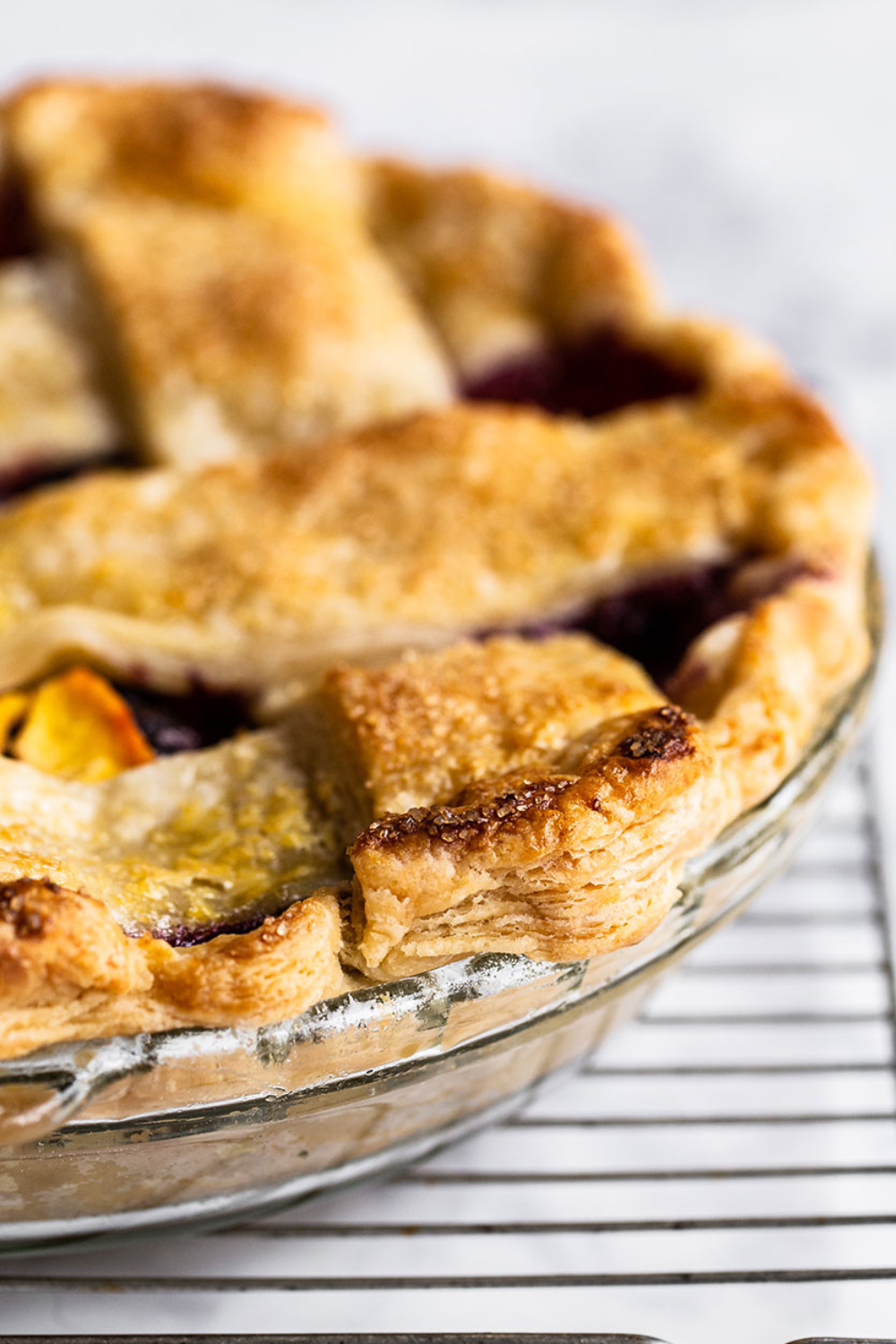
I spent weeks testing, experimenting, and researching different pie dough methods, tips, and tricks. Some worked, others didn’t.
I’m sharing a ton of tips that truly work in this post, so let’s go ahead and get right into the juicy stuff. (Or should I say flaky stuff?)

Sprinkle of Science
How to Make the Best Ever Pie Crust
For Flaky Pie Crust, Keep Everything Cold – Especially Your Butter
If your kitchen is above 73°F, you can refrigerate all of your ingredients and equipment including your bowl, rolling pin, and pie plate until it’s between 65-70°F (dip an instant-read thermometer into your flour to gauge the temperature).
If your kitchen is warm, fill freezer bags with ice and a little water and set them on your work surface for 10 minutes to chill it before rolling out your pie dough. This will prevent the butter from becoming greasy as you work with the dough.
Tip: If it’s a hot day, or you have hot hands, you’re probably better off making your pie dough in a food processor.
The Butter Size in Pie Dough
- Smaller pieces of butter typically result in a more mealy textured crust that holds up better to custard fillings.
- Larger chunks of butter will yield a flakier crust better suited for fruit fillings – but this also runs the risk of creating pools of butter as your pie dough bakes.
- Overall, the differences can look relatively minor from a visual perspective once the crusts are baked.
- If you don’t have a ton of experience or confidence in your pie dough skills, I recommend starting with smaller pieces of butter. It makes the dough much easier to work with!
- Take a look at what a difference it makes to use pea-sized vs. large chunks of butter in pie crust:
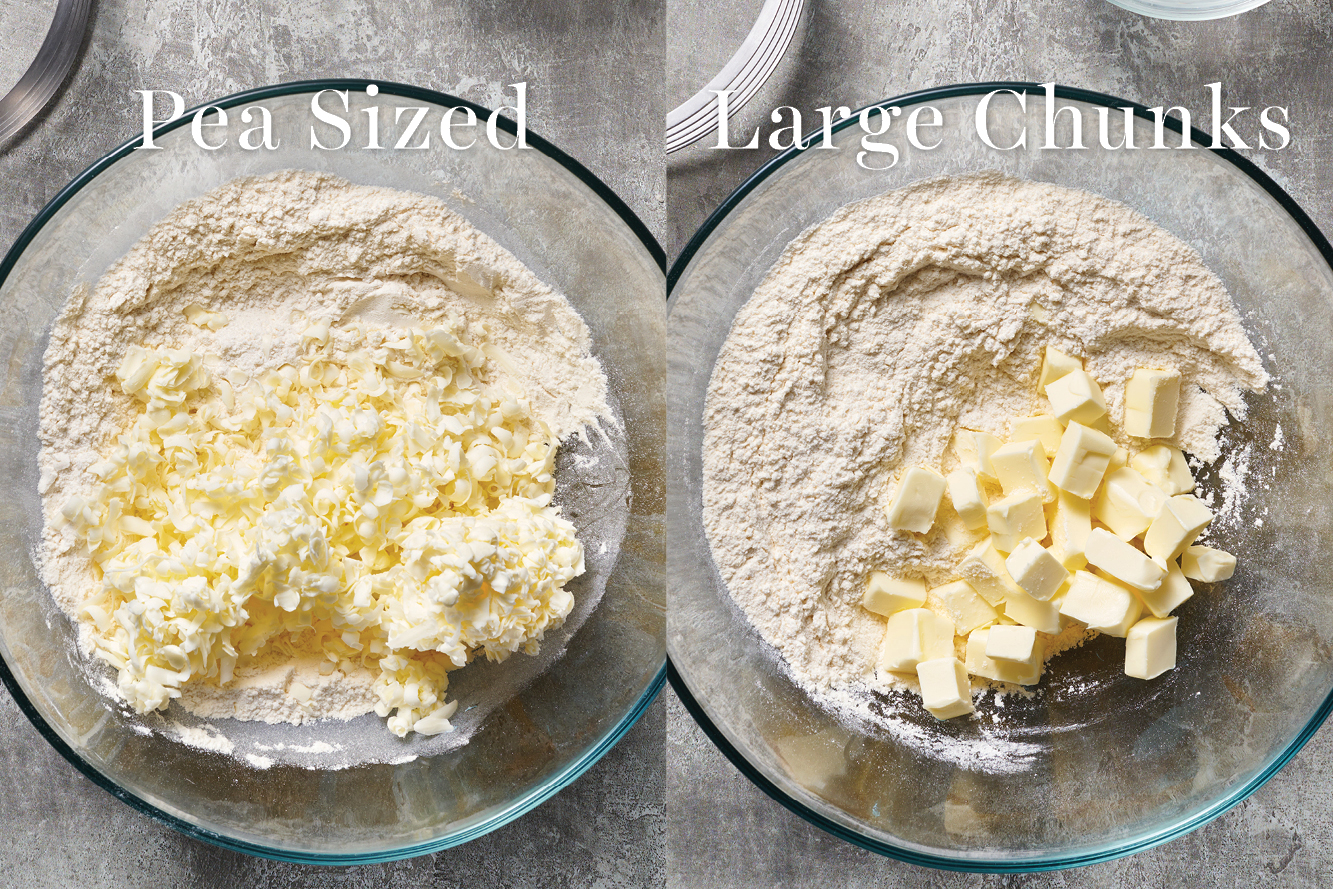
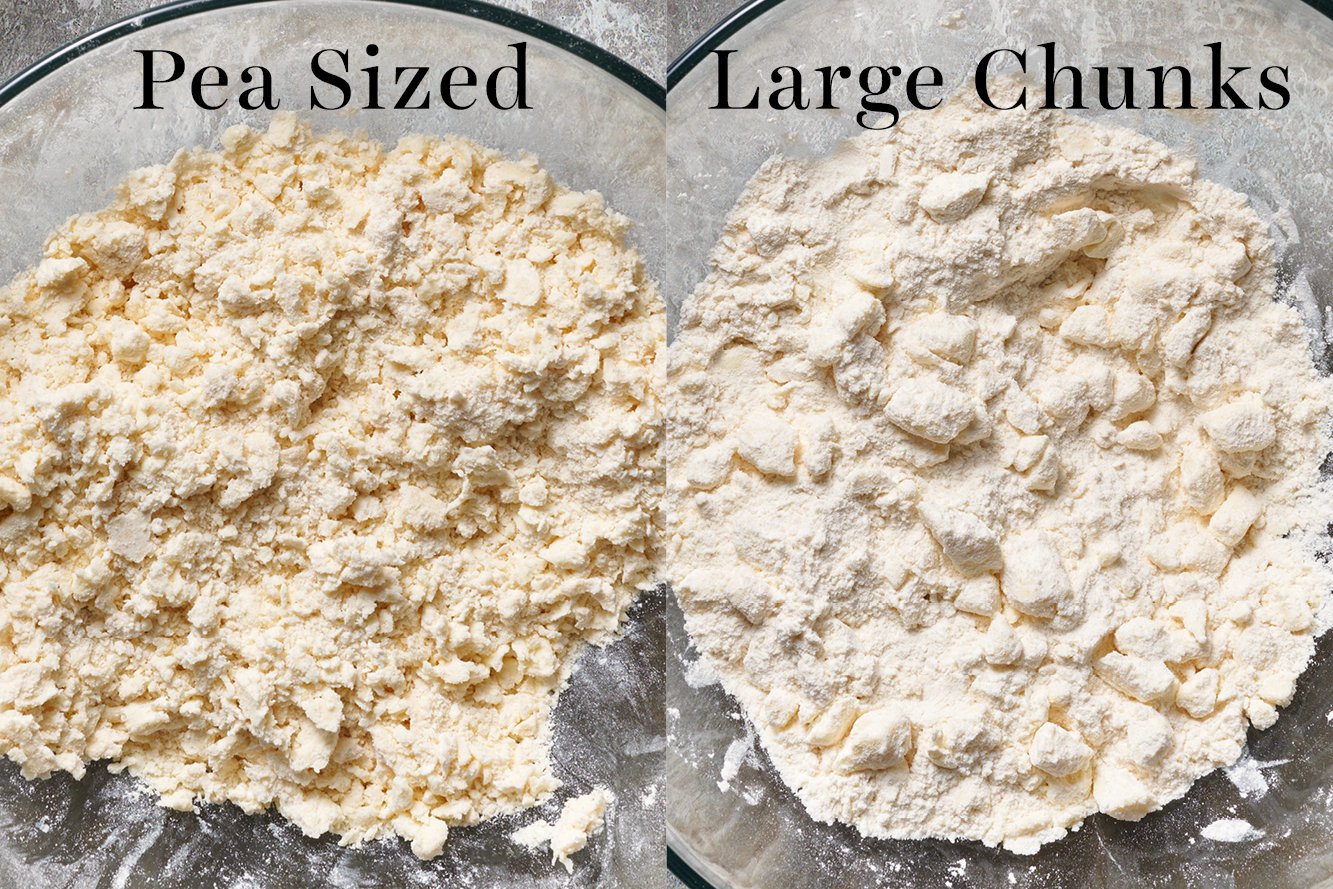
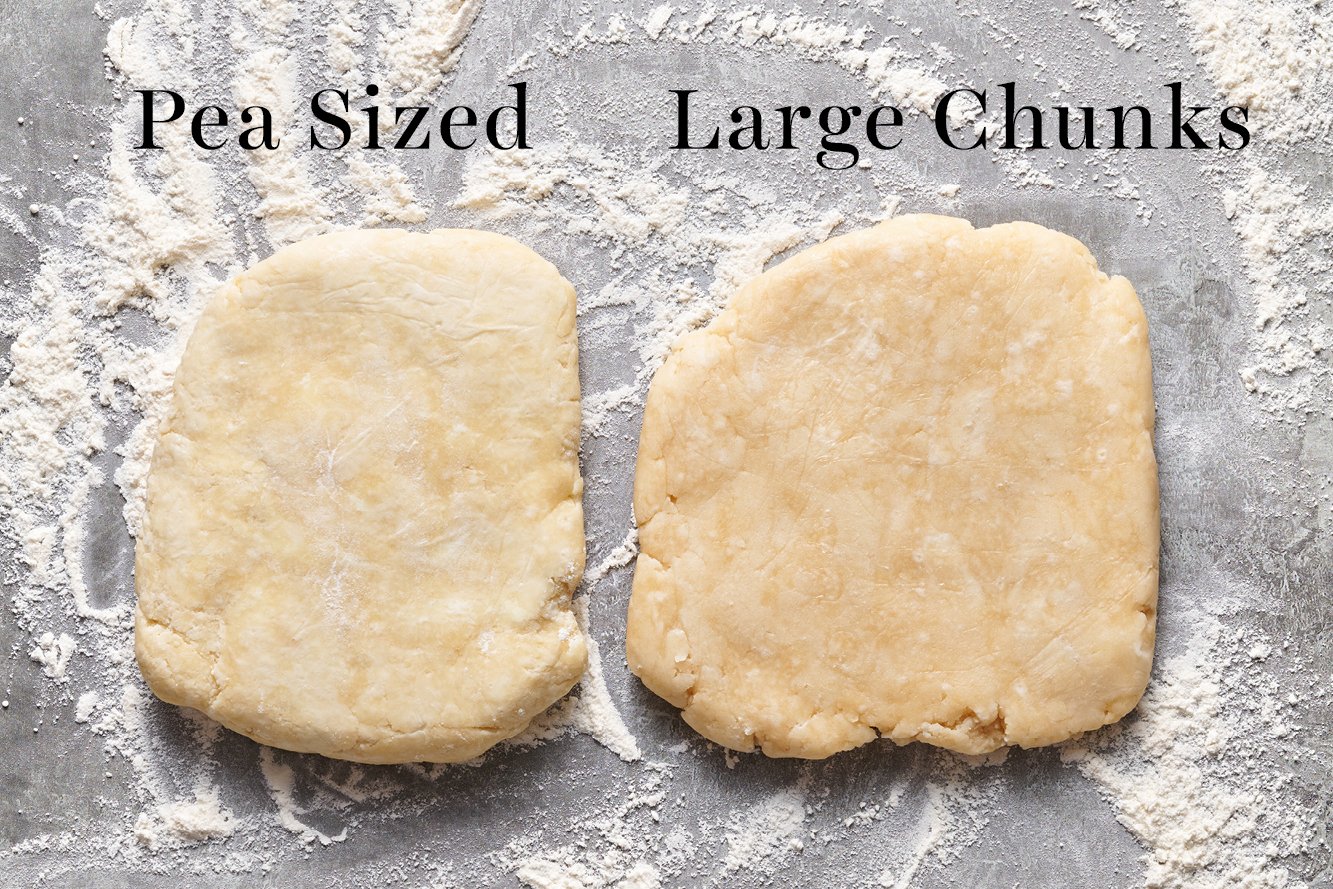
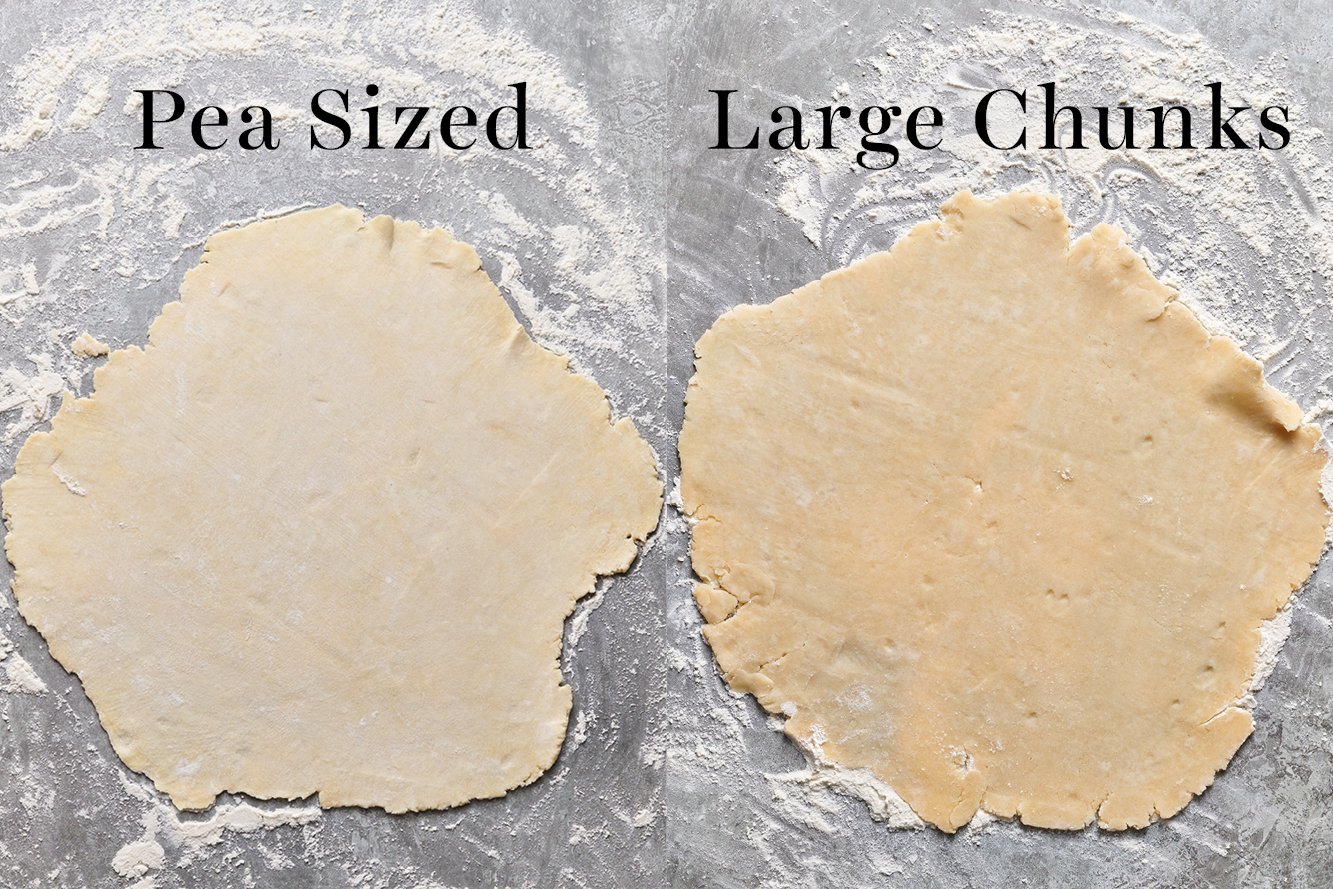
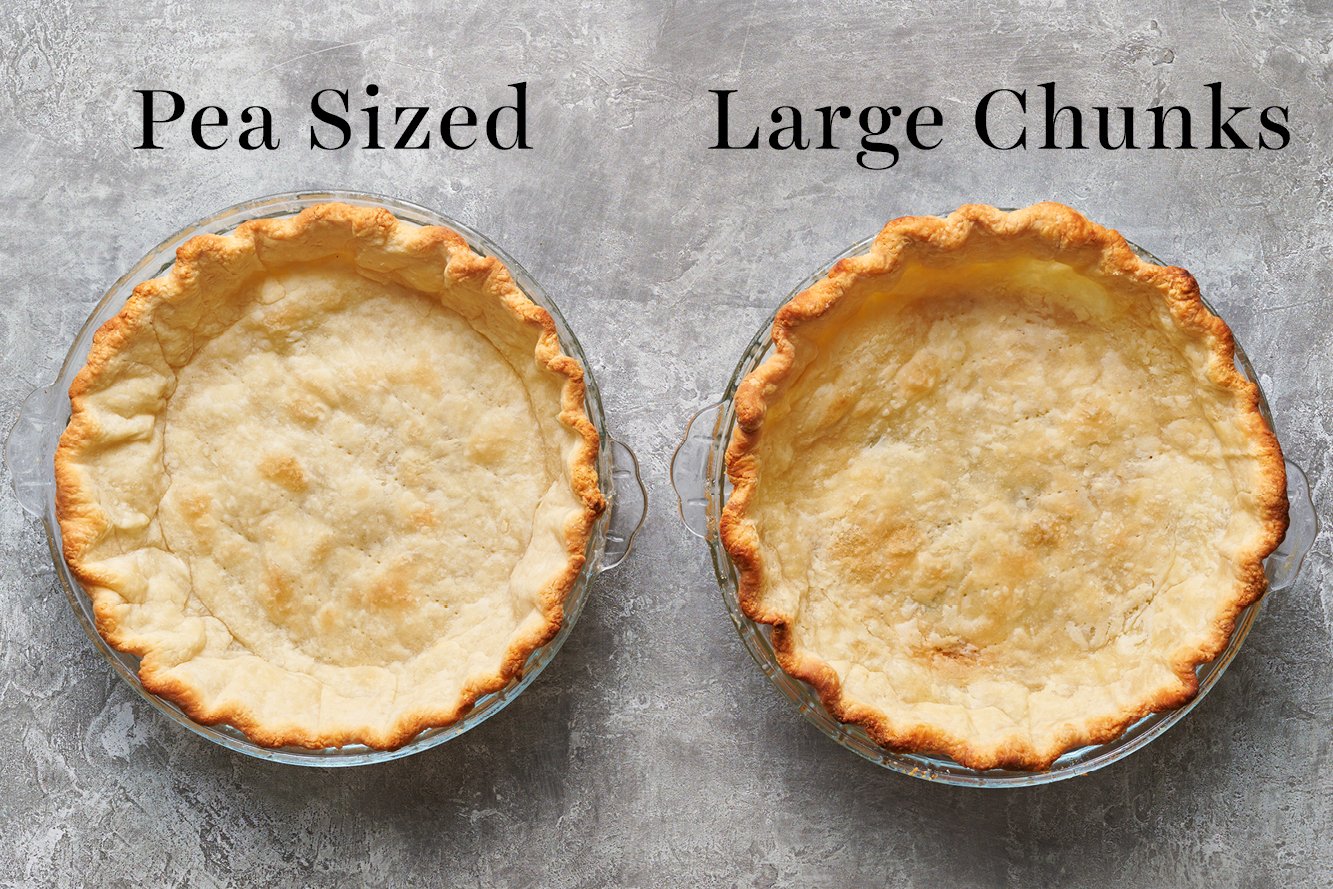
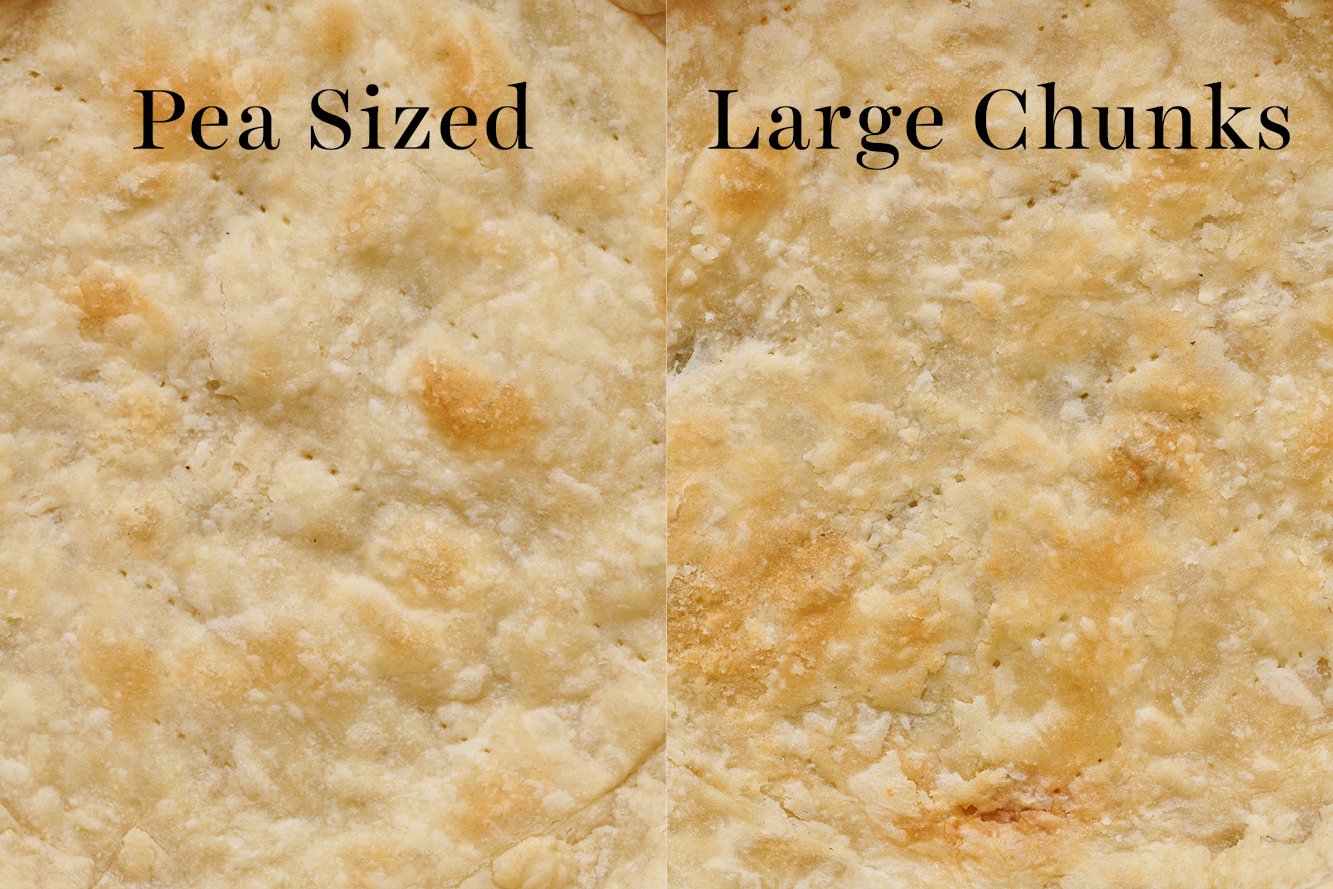
How to Cut The Butter In
It should take just a couple of minutes to cut the butter into the flour mixture, to prevent the butter warming up. For this reason, it’s helpful to start out with pieces of butter that are already small in size. I’ve included a few options for processing the butter below. My personal favorite is to grate it like cheese!
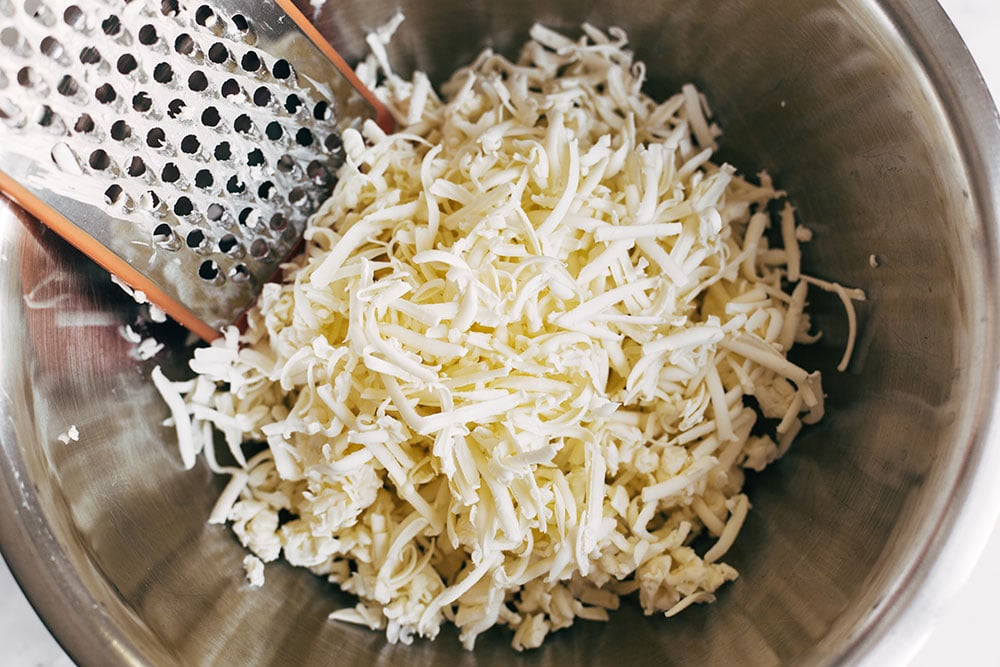
Method 1: Grate or Chop with a Knife
Freeze your butter until it’s solid. Using the large holes on a box grater, grate the butter (just like grating cheese). You can also use the grater attachment on your food processor. Return the grated butter to the freezer for another 10 minutes until it’s firm before adding into the flour mixture.
If you don’t have a box grater, use a sharp knife or bench scraper to slice it into small chunks.
Working quickly, use your hands to further break the butter into pieces the size of small peas. You can also use a pastry cutter or two knives.
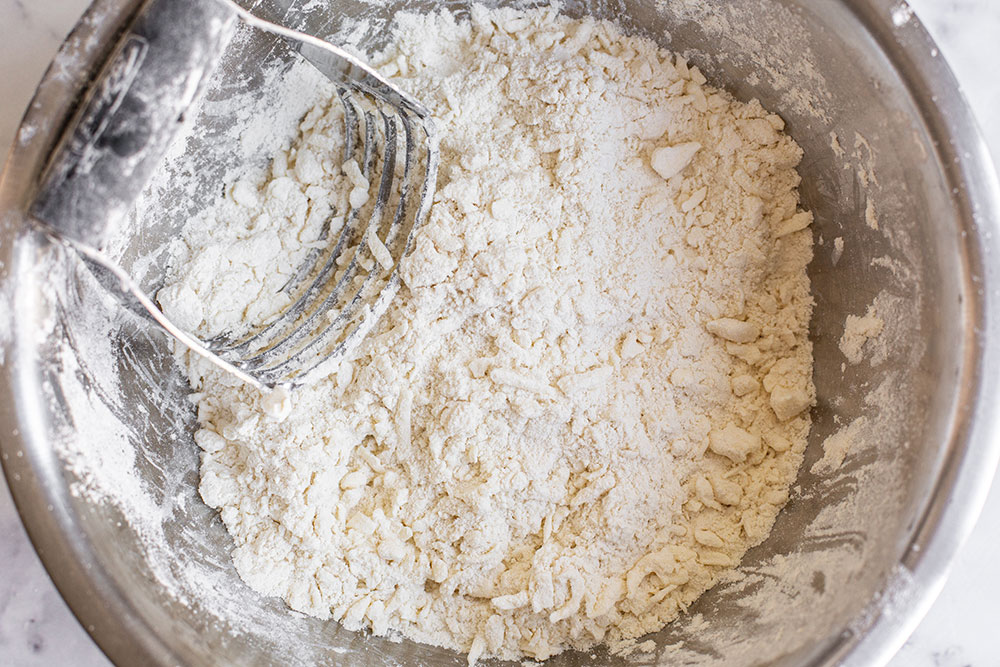
Method 2: Food Processor
Since I live in Phoenix where temperatures often exceed 85°F, I typically use a food processor to make pie dough. It’s quick, easy, and prevents the butter from warming up too much. Cube your sticks of butter with a bench scraper and freeze until firm. Add to the dry ingredients in the bowl of the food processor and pulse until the butter is the size of peas.
Why Butter Size Matters
You want the butter to end up the size of little peas. This will help bring the dough together cohesively without overworking it.
Overworking the pie dough develops more gluten, which can make the baked crust tough and dense instead of light and flaky. This can also cause the crust to shrink while it’s baking. Additionally, overworking the dough with your hands can start to melt the butter, preventing that flaky texture from forming.
Creating pea-sized bits of butter will also prevent the butter from pooling into greasy puddles as the pie bakes. I used to use larger chunks of butter and would encounter these grease pools too often, so I’ve scaled back to much smaller pieces and prefer these results.
How Much Water to Use For Pie Dough?
This is one of the trickiest parts of making pie dough. The reason is that many factors affect how much ice water you’ll need to add, such as the climate and humidity of your kitchen and the brand of flour you’re using. That’s why the recipe calls for a range of water.
Add half of the total amount to start with. Toss it in to combine either by hand or with a few pulses of the food processor.
Pick up a piece of the mixture and pinch it between your fingers. It should hold its shape. If it crumbles away or seems really floury and dry, then you need to add more water.
At this point, I like to turn the mixture out onto a work surface and begin pressing it together into one messy lump of dough. Doing so will give you a better indication if you need to add more water.
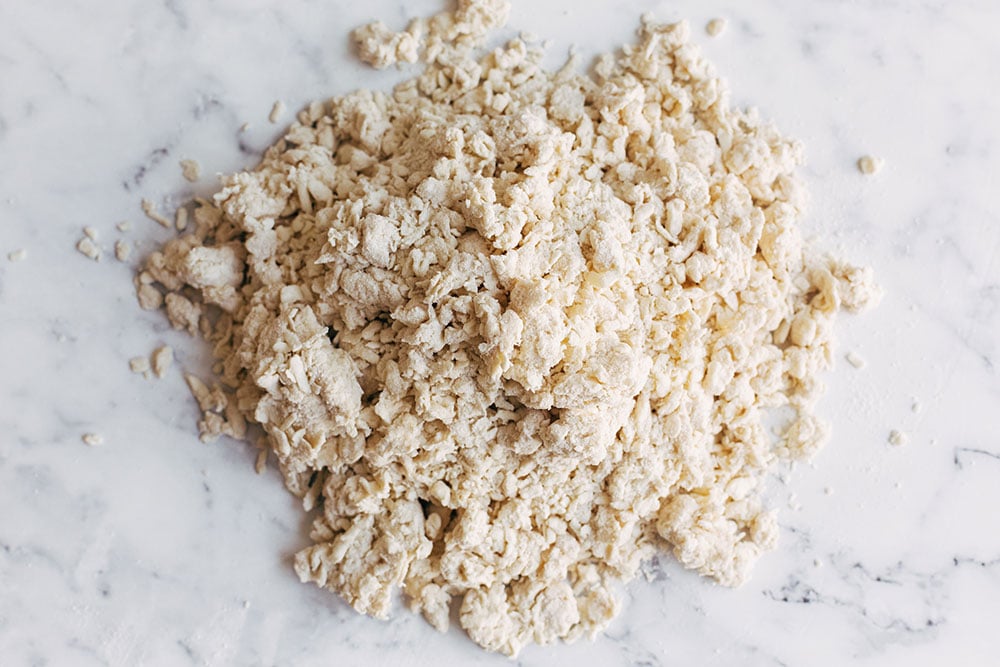
Bringing the Dough Together for Maximum Flakiness
The dough won’t look like much at first. It’ll be kind of craggly and messy looking, and that’s okay.
Once you have a fairly cohesive mound of dough, flatten it into a disk and fold it onto itself, kneading gently as you work.
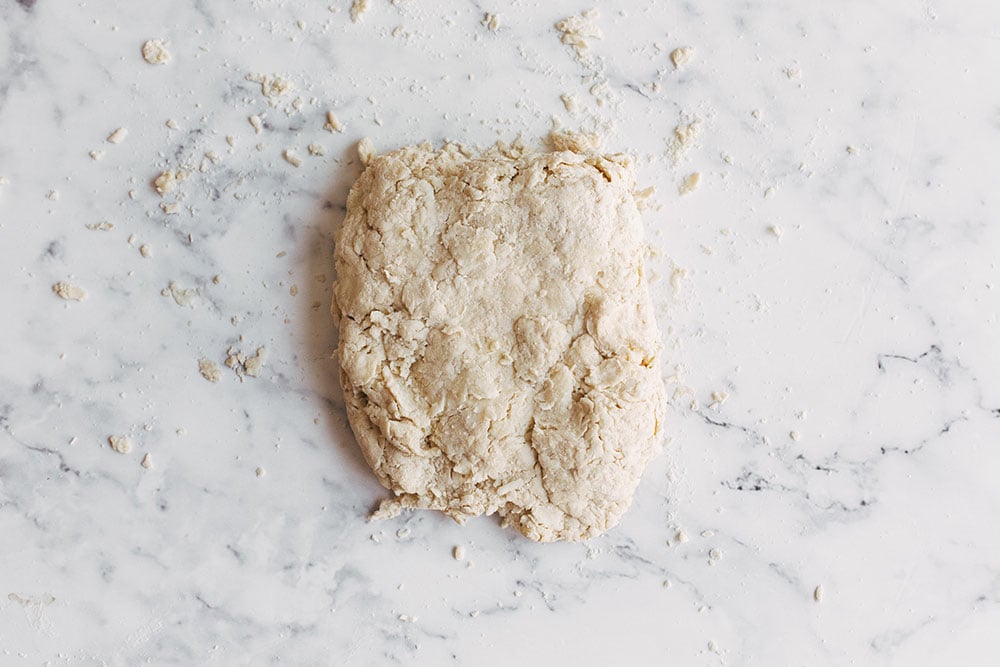
Do this a couple of times to ‘laminate’ the dough. Every fold will give you more flaky layers. Just be careful to be gentle and work the dough only until it comes together into a smooth cohesive disk like this:
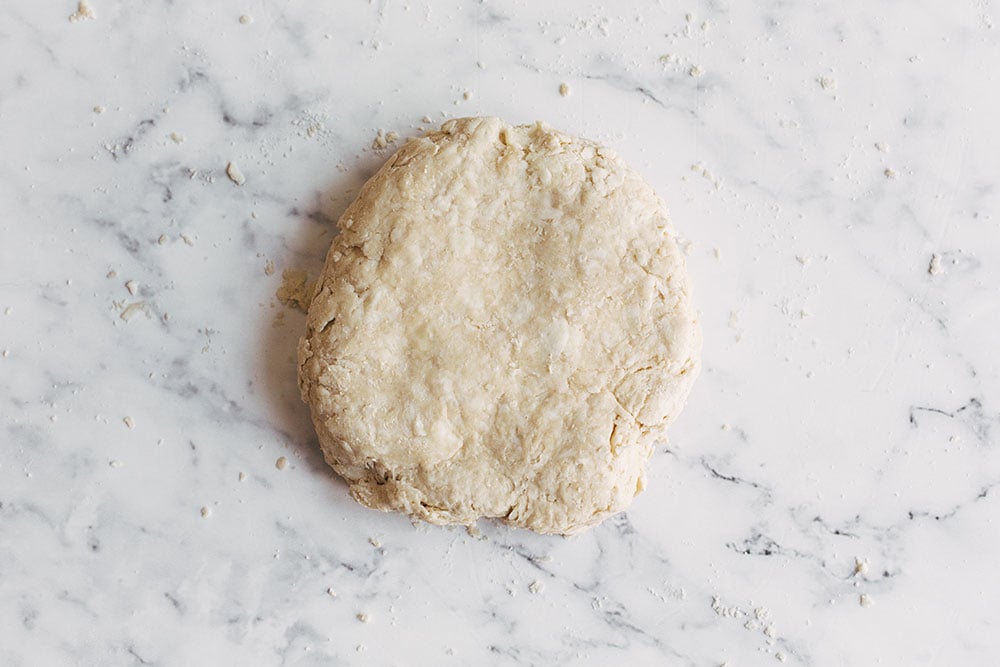
If you were to cut the mass in half, such as for a double-crust pie, you can visibly see the layers of butter thanks to that extra folding step. These layers are going to bake into crispy, tender, flaky goodness:
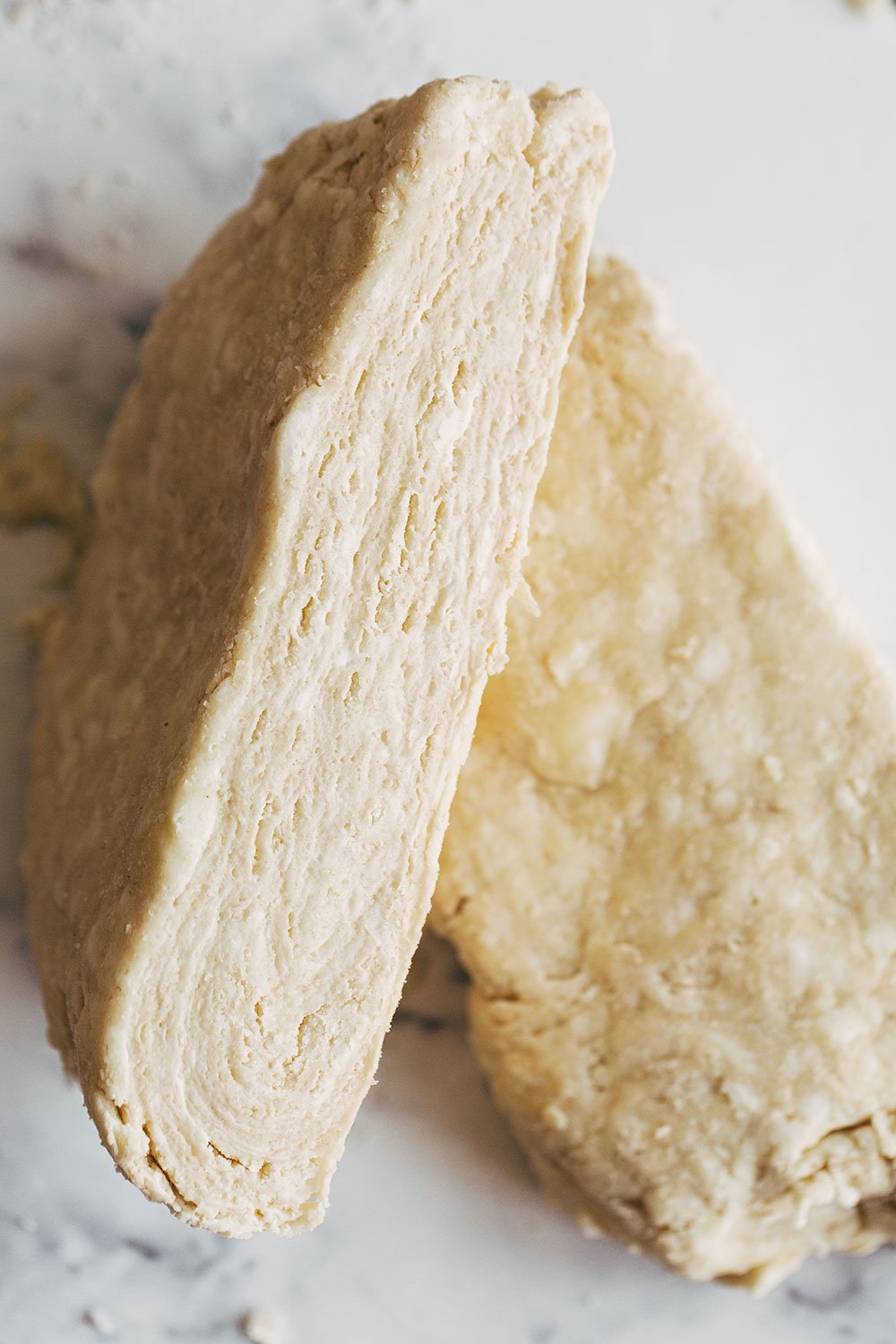
Give the Dough a Rest
If you have problems with your crust shrinking while baking, or your crust is tough, it needs more time to rest so the gluten can relax and it doesn’t snap back to its original smaller shape. I’ve included these resting periods in the recipe directions.
- After mixing: Wrap the dough in plastic wrap and refrigerate overnight. You can shorten this to a few hours if you must, but I find overnight really makes a difference in preventing classic pie issues.
- After rolling out: After rolling out and placing in the pie dish, cover and allow the pie dough to rest again.
- Rolling out tip: Do NOT stretch the dough to fit into the tin, as it will snap back like a rubber band while baking.
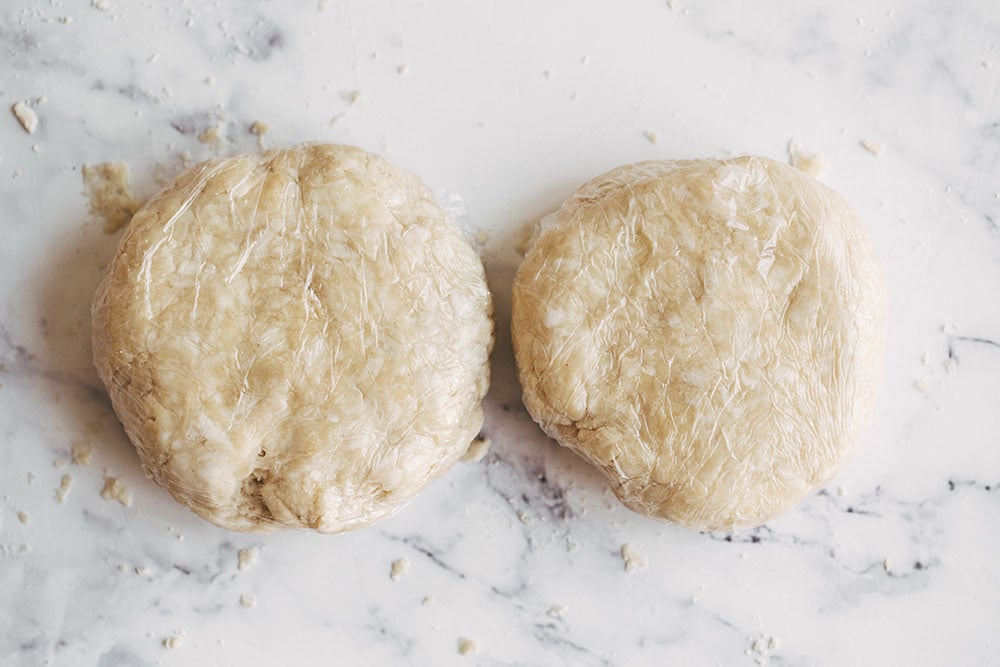
How to Roll Out Pie Dough
I typically roll out my dough on a marble pastry board, but that is totally optional. You can use the trick I mentioned above of icing down your counter before rolling to help keep things nice and cool.
Avoid overworking the dough as you roll it out. Keep the dough moving on a lightly floured surface so you don’t roll over the same areas repeatedly to avoid a tough crust.
If at any point the butter begins to get melty and sticky, return the dough to the fridge immediately.
You’ll want about a 12-inch diameter for a 9-inch pie pan. Some pans are deeper than others, so factor that into your rolling.
Be sure to roll to a thickness of about 1/8-inch. Thinner will result in rips and tears. Thicker and it won’t cook through and get flaky.
Use your fingers to flute the edges of the pan if you wish. I find that I need to make a more dramatic flute than I might think since the design will loosen during baking. Whatever you do, don’t make the flute too thick and heavy, otherwise it’ll slump down the sides.
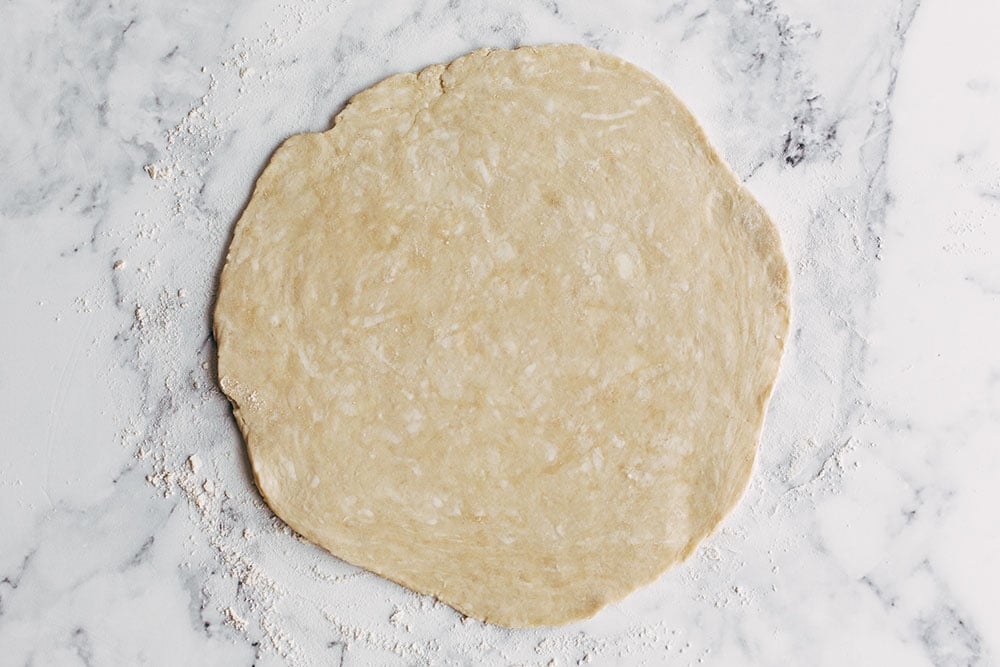
Flour your work surface, the dough itself, and your rolling pin throughout the process as needed. There are two inexpensive tools that I find are both a MUST when it comes to rolling out pie dough: a flour shaker and a bench scraper.
The flour shaker allows you to easily add flour wherever sticking might be happening. The bench scraper allows you to easily keep the dough moving as you roll it out, which is essential. I keep the dough moving in quarter-turns to prevent sticking and to keep it an even thickness.
Alternatively, you can roll the pie dough out between two sheets of parchment paper or plastic wrap. I find that most non-commercial paper and plastic wrap isn’t big enough to accommodate a 12- to 14-inch diameter circle, so I don’t often use this method.
More Dough Than Other Recipes?
You might notice in the recipe below that I call for more ingredients than other recipes. This is because I think it’s easier to work with dough when you have a little more than you may need. It comes together more cohesively and if you get any rips, tears, or make any mistakes with a design, you have extra.
This especially comes in handy if you have a deeper pie dish or if you want to get fancy with any designs.
Pie Crust: Butter vs. Shortening?
I’ve done an extensive amount of testing on pie crust. Let’s just say my kitchen has seen a LOT of butter. I made the messes and did the testing so you don’t have to. Here’s what I learned.
When it comes to pie dough, I’ve heard a lot of confusing and conflicting opinions about which is the better fat. If you’re curious, you can learn more about the general differences between butter and shortening here. But I actually tested the two fats in pie crust side-by-side to compare. I still need to do testing with lard, so stay tuned for that!
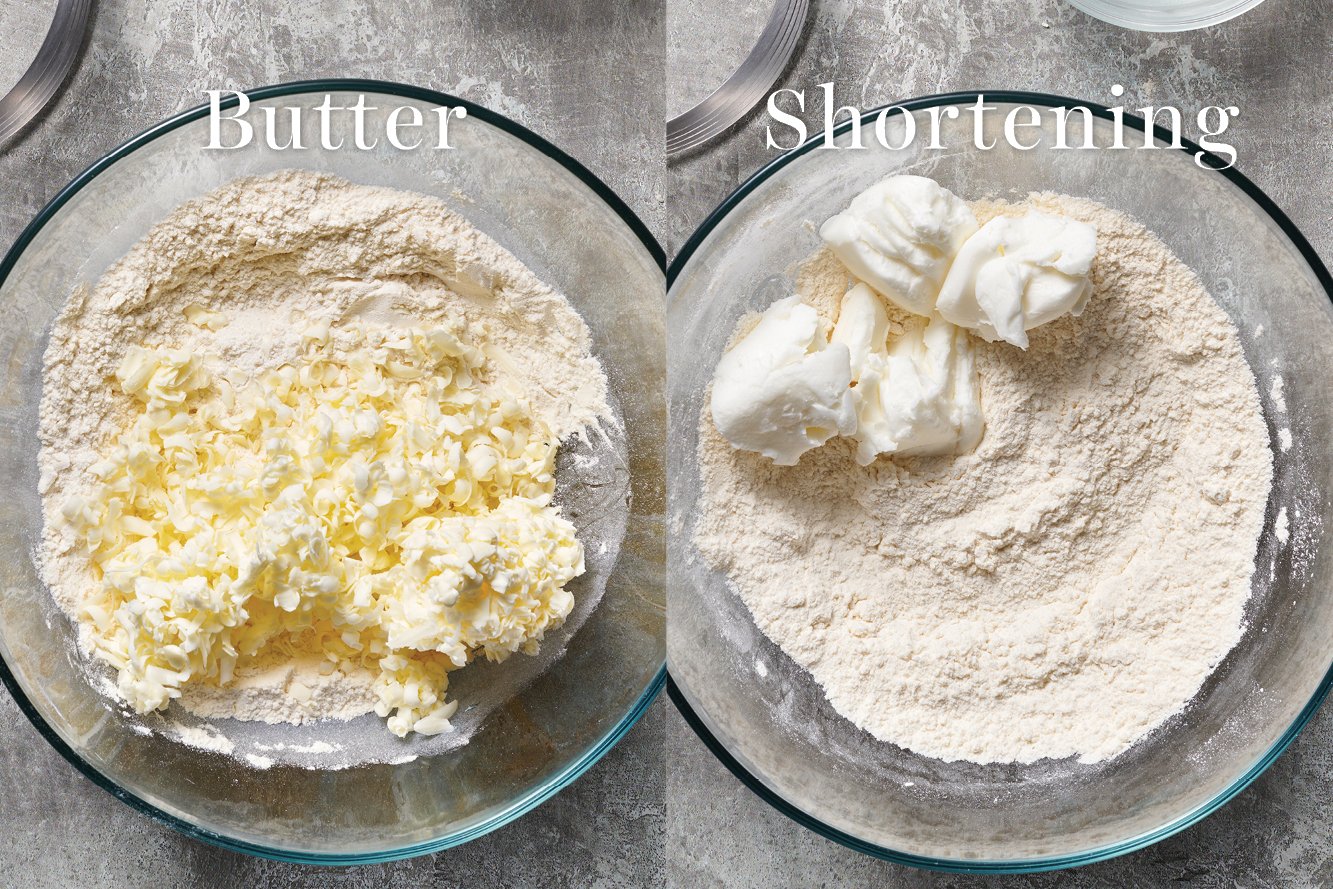
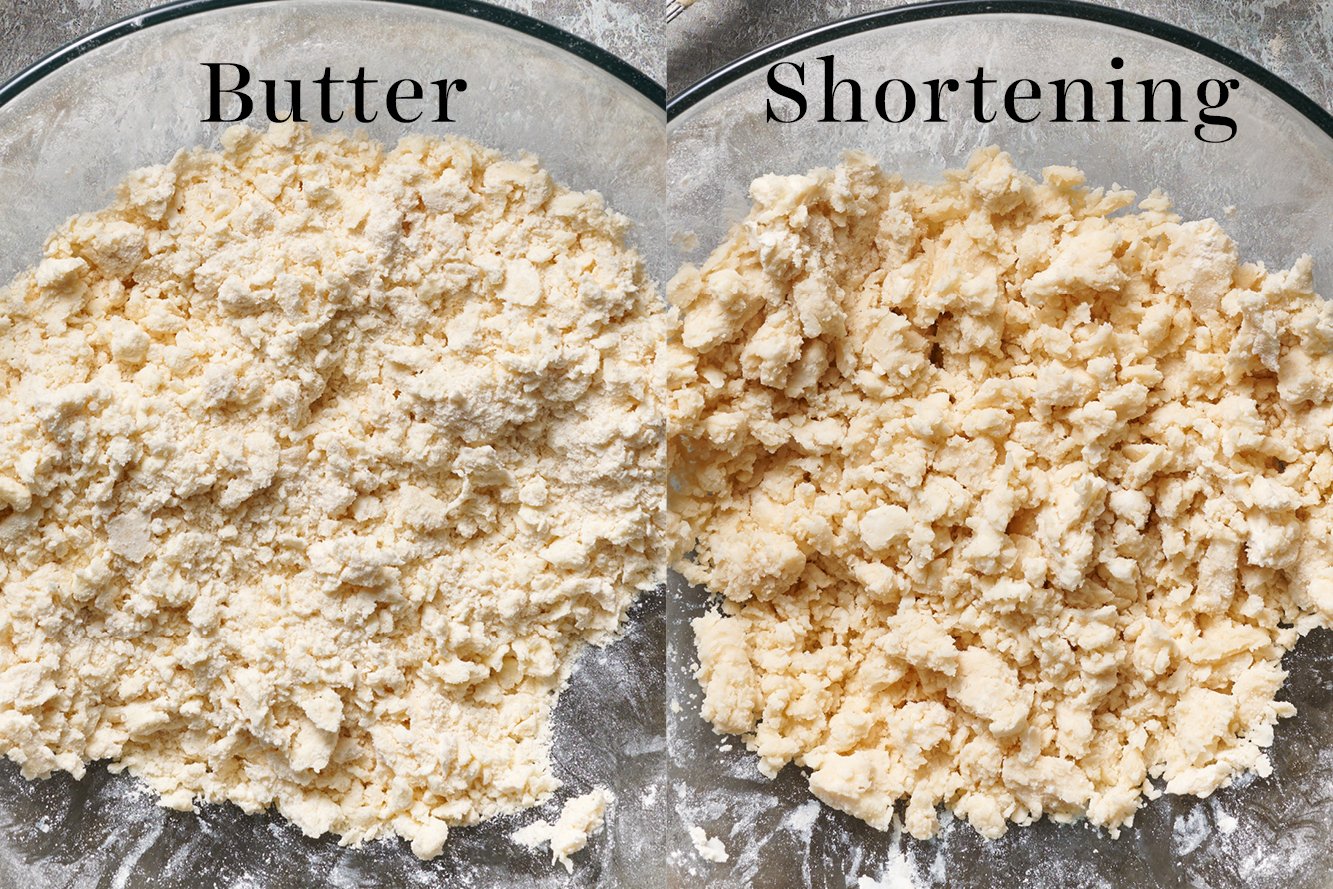
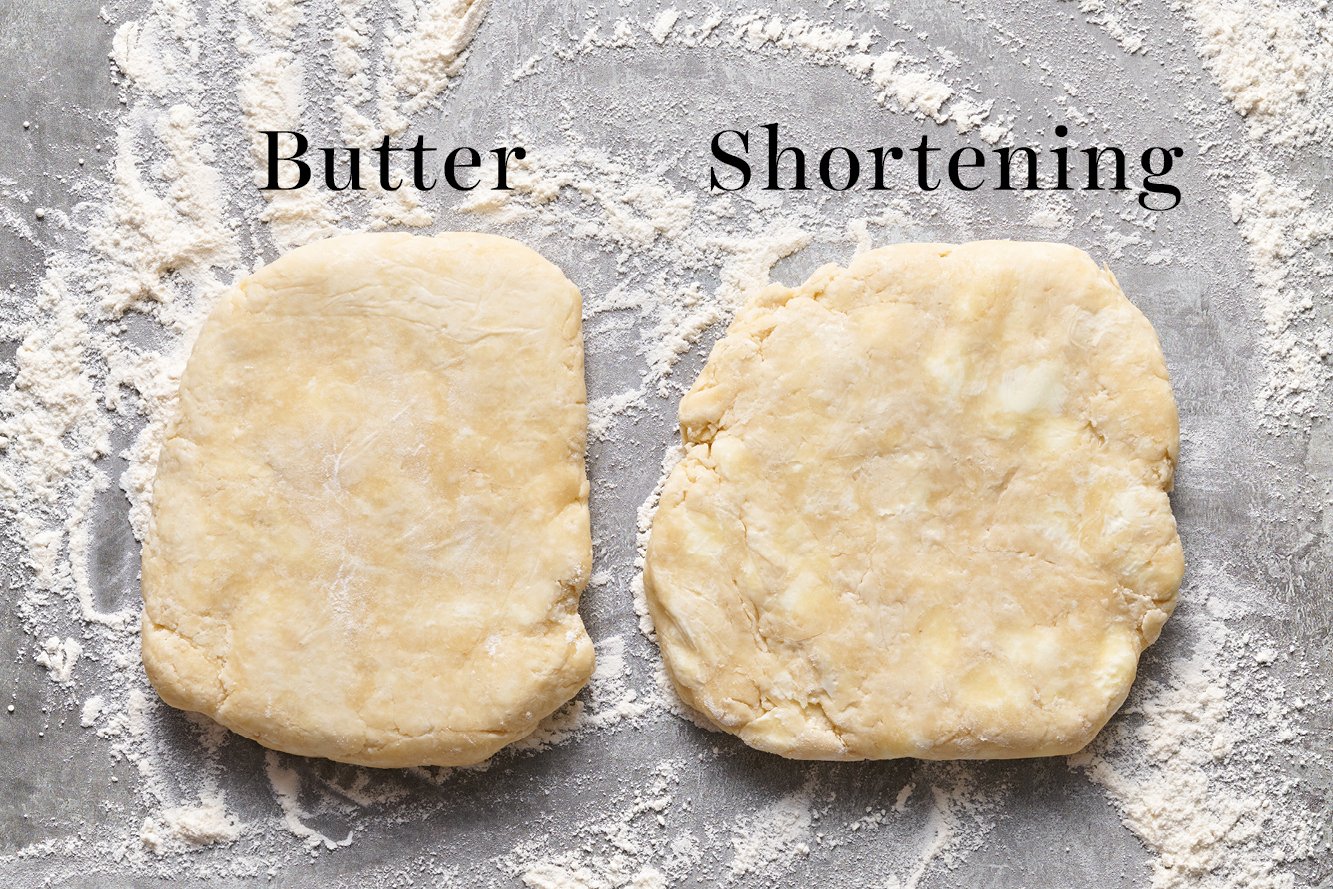
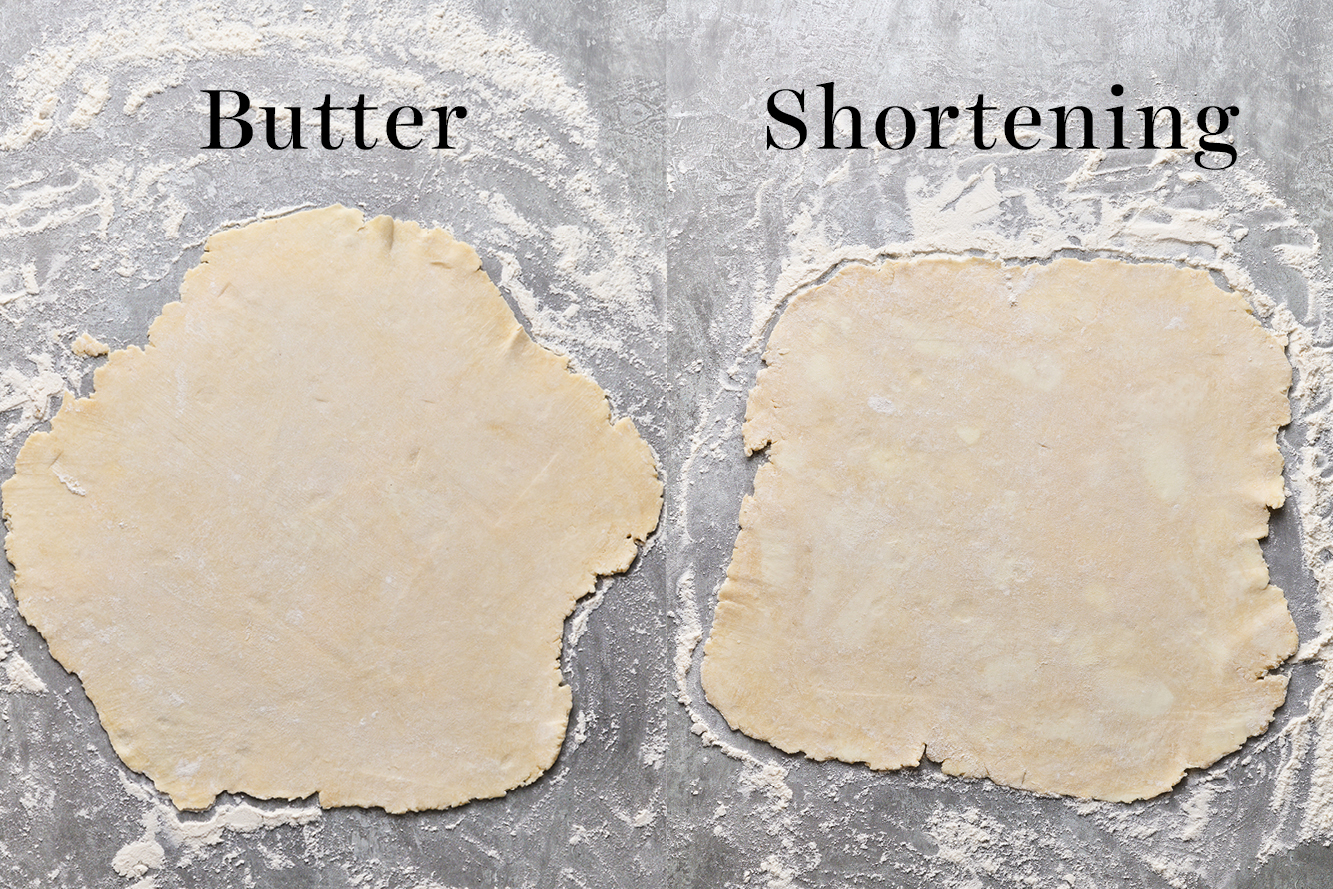
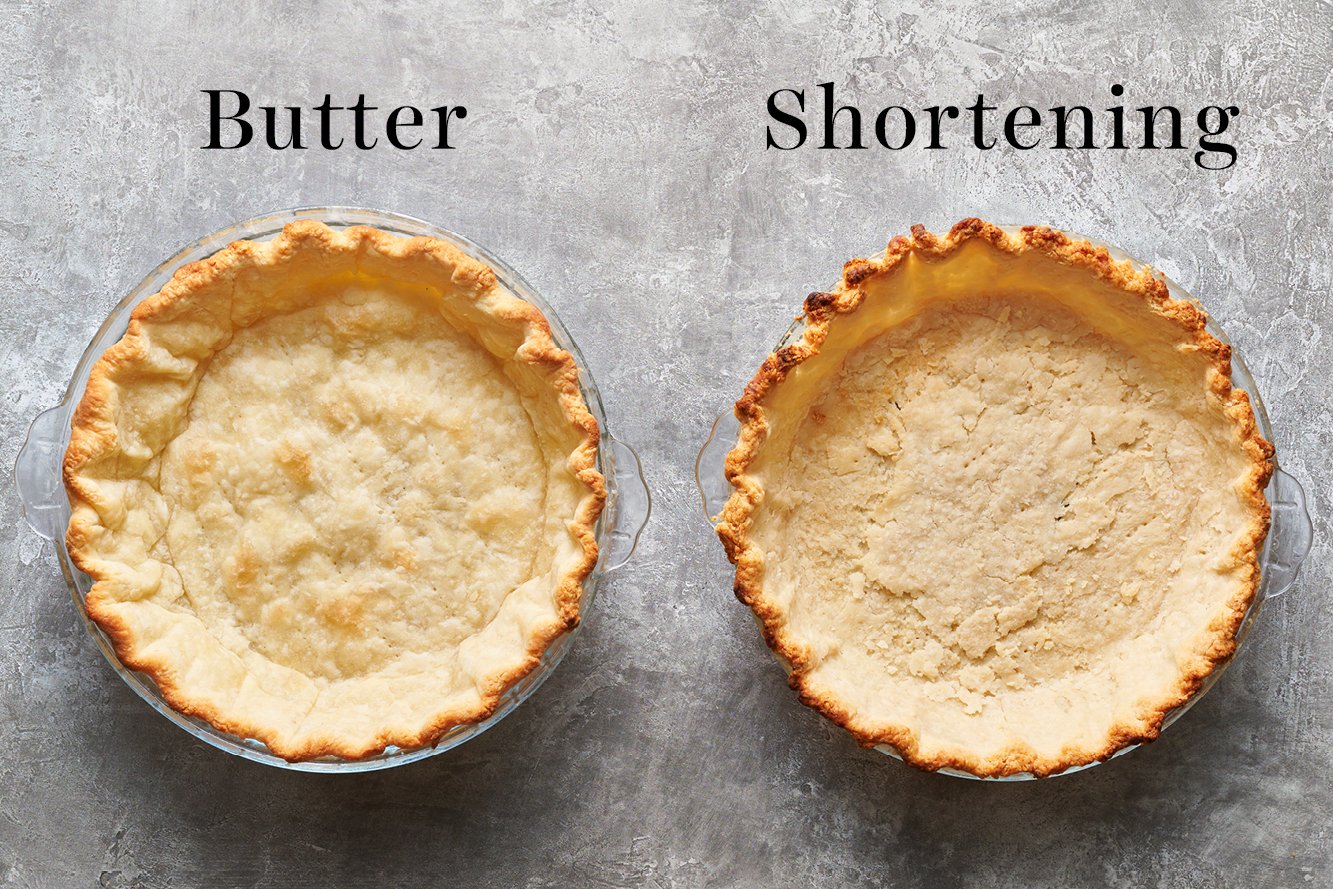
All-Shortening Pie Crust
All-shortening dough can be easier to work with in one sense because shortening requires less chilling time than butter, and it has a higher melting temperature than butter. However, this also means that unlike the very hard chunks of cold butter that remain in the control dough, shortening is soft enough that it is easily overworked, resulting in a crumbly crust instead of a flaky crust.
In our blind-baked shortening crust, the parchment paper holding the pie weights actually stuck to the crust, pulling some of it off with it.
As you can see in the photograph, the all-shortening dough ended up being flat, tender, and fairly crumbly. The texture was actually reminiscent of shortbread, and it was completely lacking in flavor. In fact, the flavor reminded me of store-bought pie dough.
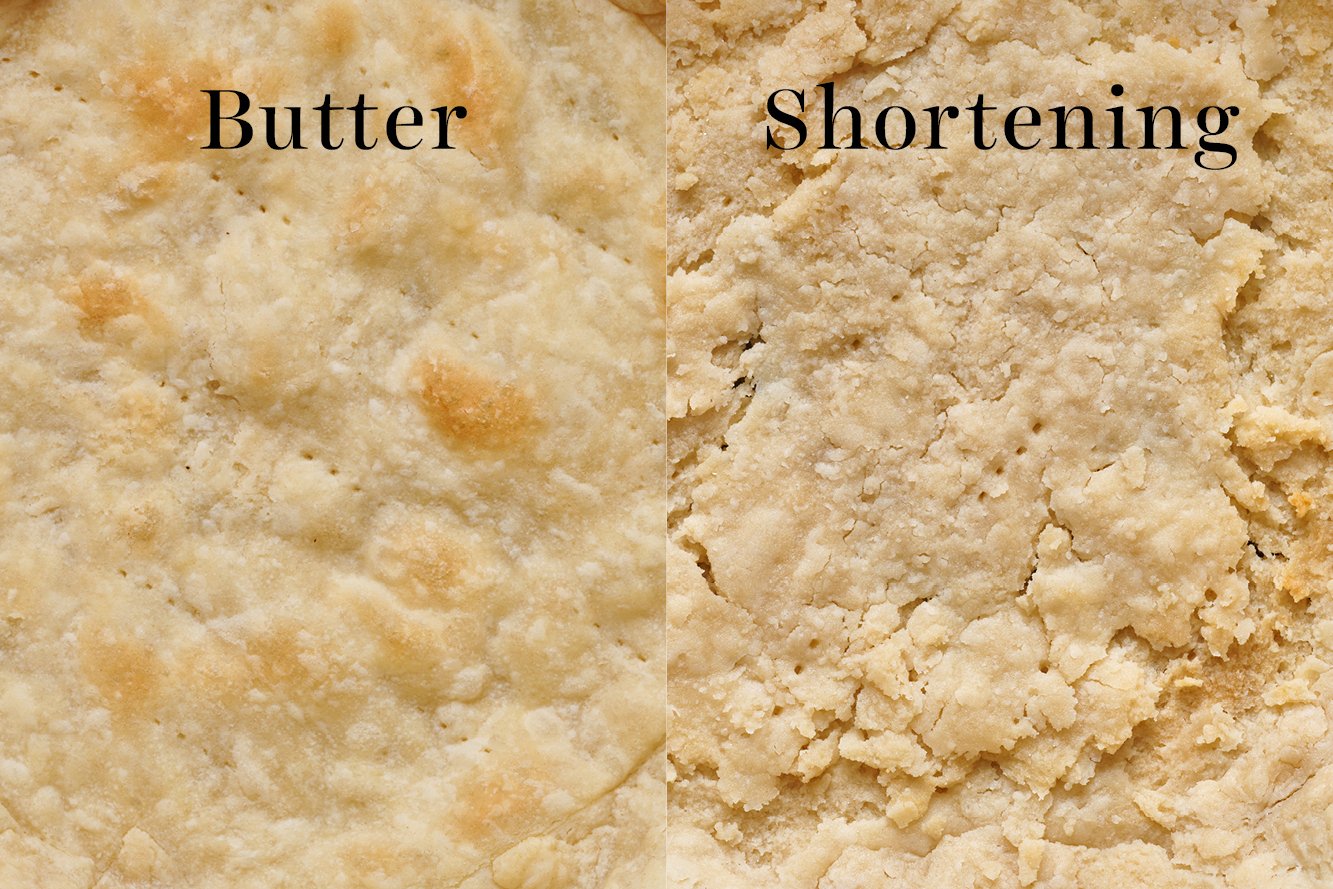
All-Butter Pie Crust
There were plenty of visible chunks of butter studded throughout our all-butter dough. Once it came together and was chilled, it was a bit of a challenge to maintain that perfect temperature where it’s warm enough to shape but cold enough that the butter doesn’t melt. Especially for me living in the desert.
The extra effort paid off immensely, though. This pie crust was ridiculously light, flaky, and loaded with rich buttery flavor. You could immediately tell this was homemade, in the best way. This is why I almost always prefer a 100% butter pie crust.
If you like the benefits of shortening, then I’d recommend a 50-50 ratio of butter and shortening to get the best of both worlds.
Other Pie Crust “Tricks” Put to the Test
Vodka in Pie Crust
A few reputable sources have claimed that by substituting a portion of the water with vodka in a pie crust recipe, you prohibit gluten development and therefore ensure a tender, flaky crust. I tested this against my standard pie crust recipe and found the differences to be slight. I don’t think it’s worth the extra effort if you don’t have chilled vodka on hand.

Optional Secret Ingredient!
As you can see, I’ve done a lot of side-by-side testing of pie crust variations. Most of the time the classic recipe has won out, with a single exception: sour cream!
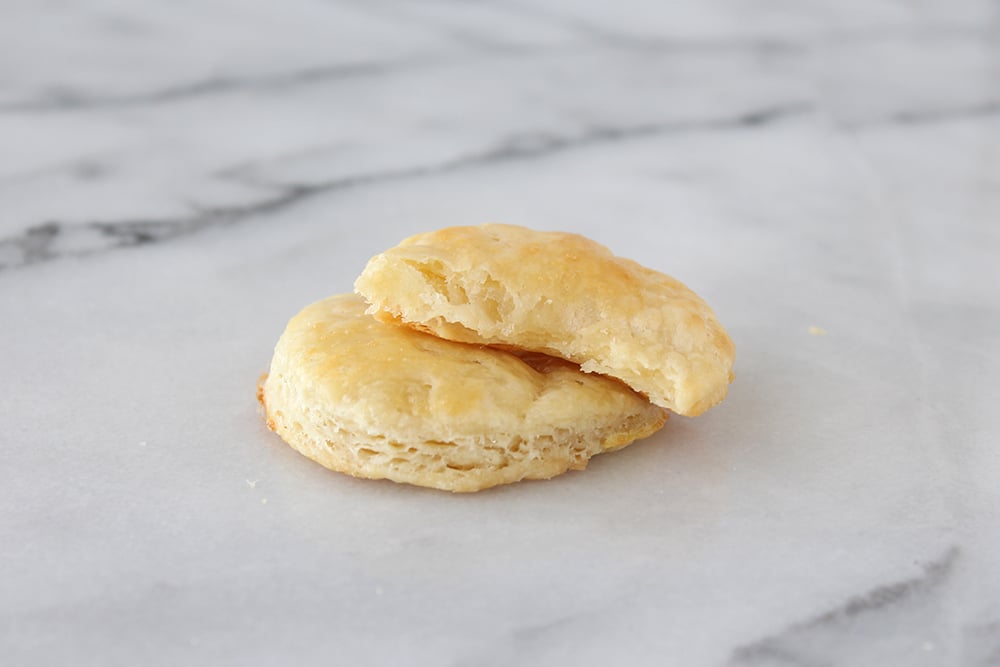
Sour cream acts as a tenderizer in baked goods, and I was curious to see if it would significantly affect the texture of pie crust.
- I added 2 tablespoons of sour cream to my standard single recipe along with the butter.
- This dough was very soft and slightly sticky, but easy enough to work with.
- The texture was ultra-light, puffy, and flaky, almost like puff pastry.
- This pie crust puffed up to a surprising height.
- If you have sour cream handy, I definitely suggest giving it a shot.
How to Add Sour Cream
Add in 2 tablespoons to the single recipe below, and reduce the water by about 2 tablespoons, or as needed.
Can you Make Pie Dough Ahead of Time?
Yes! Here are your options:
1. Chilling the dough disk: Pastry dough can be shaped into a disc and refrigerated for up to 3 days, as long as it’s well wrapped in plastic wrap.
2. Chilling the unbaked pie shells: Refrigerate for up to 3 days. Simply roll out your dough, lay it into your pie tin, crimp the edges, and cover loosely with plastic wrap. When ready, simply remove from the fridge, fill, and bake. This works perfectly for single-crust pies like pumpkin or sweet potato.
3. Freezing dough: Pastry dough can also be shaped into a disc and frozen for up to 2 months, well wrapped in plastic, and placed in a freezer bag or airtight container. Defrost in the fridge overnight before rolling out.
4. Freezing pie shells: Unbaked pie shells can also be covered and frozen for up to 2 months. No thawing necessary.
How to Bake Pie Dough
I’ve included instructions on how to blind-bake the crust for recipes that require an already-baked crust. Check out my full article on How to Blind Bake Pie Crust here!
Place your pie pan on a rimmed baking sheet before putting in the oven. This helps you to remove the pie tin without damaging the crust with your oven mitts. Better yet? Place the sheet on a baking stone to ensure a golden crispy bottom crust and avoid any sogginess.
Otherwise, just follow the directions in the pie recipe you’re following!
The Best Pie Pan
The material of your pie pan can make a big difference in how your pie bakes. I recently used this Best Ever Pie Crust recipe to experiment with different pie pans to determine which pie pan is best. Check out my Best Pie Pan article here to see my side-by-side experiments using glass, ceramic, metal, and disposable pie pans, and learn which pie pans I recommend.
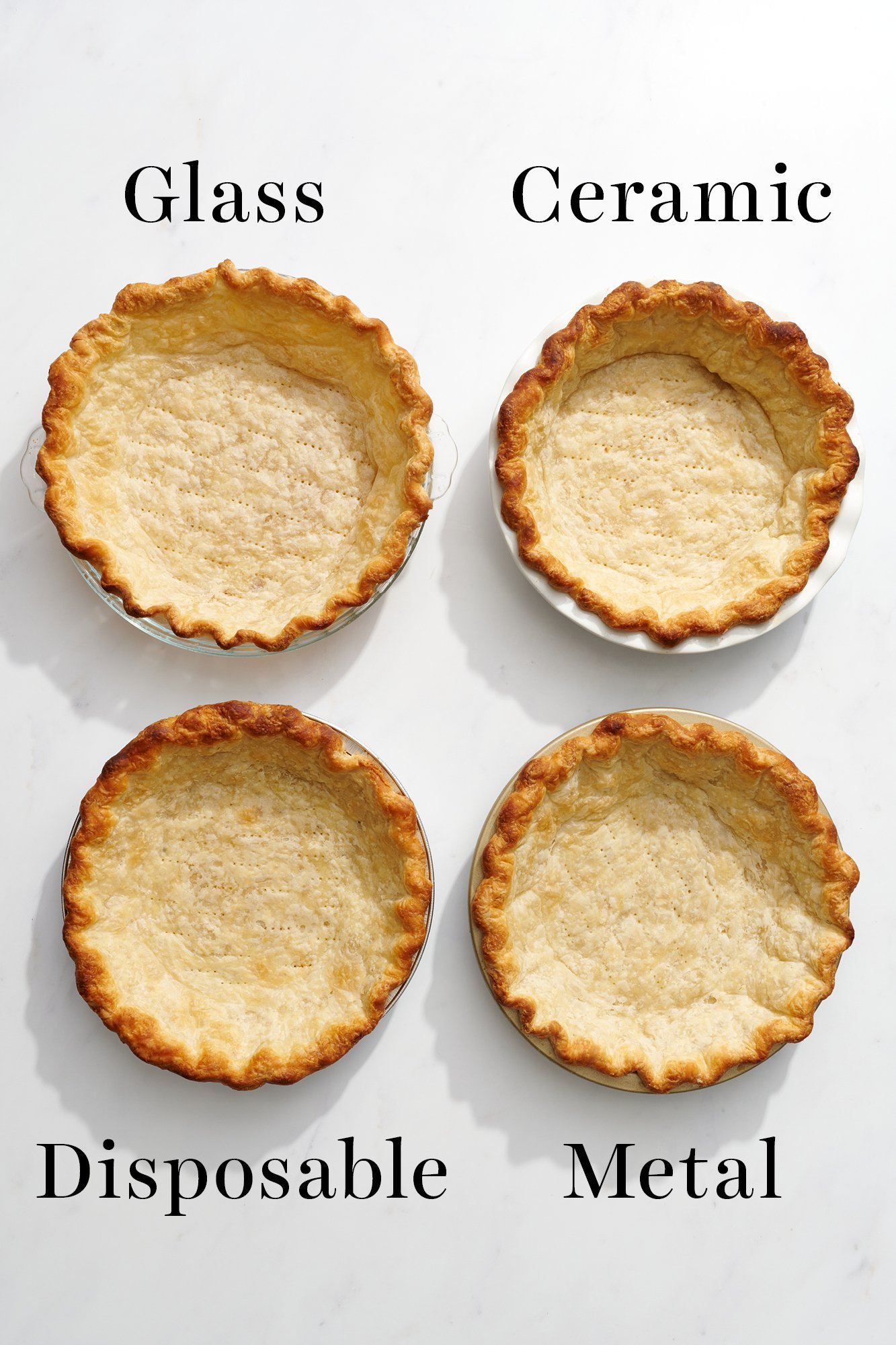
Delicious Pie Recipes to Try:
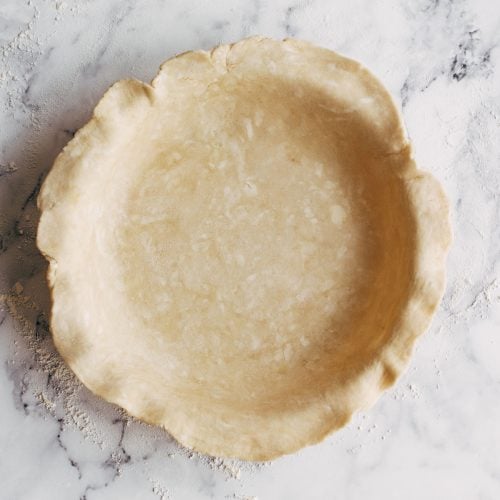
Best Ever Pie Crust
Email This Recipe
Enter your email, and we’ll send it to your inbox.
Ingredients
Single crust:
- 1 1/2 cups (191 grams) all-purpose flour
- 1 tablespoon granulated sugar
- 3/4 teaspoon fine sea salt
- 10 tablespoons (142 grams) cold unsalted butter
- 4 to 6 tablespoons ice cold water
Double crust:
- 3 cups (381 grams) all-purpose flour
- 2 tablespoons granulated sugar
- 1 1/2 teaspoons fine sea salt
- 2 1/2 sticks (284 grams) cold unsalted butter
- 1/2 cup to 3/4 cup ice cold water
Instructions
Make the dough:
By hand:
- Freeze your butter for 10 minutes, or until very cold. Grate the butter using the large holes of a box grater (or using the grater attachment of your food processor – see below). Return grated butter to freezer for another 10 minutes. Alternatively, you can also shred frozen butter into shards using a sharp knife.
- In a deep, medium-sized mixing bowl, combine the flour, sugar, and salt. Add the cold grated butter, tossing to combine. Working quickly, use your hands to further cut and break the butter into pieces the size of small peas. You can also use a pastry blender or two knives.
- Drizzle a few tablespoons of water on the mixture and toss to moisten. Continue adding the remaining water until the dough sticks together and stays stuck when pressed between two fingers. It’s okay if the dough is still crumbly and messy.
- Turn the mixture out onto a clean work surface. Use your hands to press the dough together into a craggily mass. Gently fold one half of the dough over and onto itself, repeating this three times, until it’s come together into a cohesive mass.
- Use a bench scraper to cut the dough in half (if making double crust). Wrap each half in plastic. Press down each plastic-wrapped dough to create a 4-inch wide disk shape. Refrigerate at least six hours, preferably overnight.
By food processor:
- Freeze your butter until hardened, then use the grater attachment of your food processor to shred it. If you don't have the grater attachment, use a bench scraper to cube cold but not frozen butter into 1/2-inch pieces. Freeze the cubed butter for 10 minutes.
- In the bowl of a food processor, add the flour, sugar, and salt. Pulse a few times to combine. Add the cold grated or cubed butter and pulse for about 30 seconds, or until the butter pieces are uniform in size.
- Drizzle a few tablespoons of water on the mixture and pulse briefly a few times to moisten. Continue adding the remaining water until the dough sticks together and stays stuck when pressed between two fingers. It’s okay if the dough is still crumbly and messy.
- Turn the mixture out onto a clean work surface. Use your hands to press the dough together into a craggily mass. Gently fold one half of the dough over and onto itself, repeating this three times, until it’s come together into a cohesive mass.
- Use a bench scraper to cut the dough in half (if making double crust). Wrap each half in plastic. Press down each plastic-wrapped dough to create a 4-inch wide disk shape. Refrigerate at least six hours, preferably overnight.
Roll out the dough:
- Let the dough sit at room temperature for 5 to 10 minutes, or until slightly pliable.
- Roll the dough out on a floured work surface. Keep turning the dough after every roll to ensure it doesn’t stick to the counter and is of even thickness. Add additional flour to the dough, the counter, and your rolling pin as needed. Roll out into a 12-inch circle about 1/8-inch thick.
- Gently roll the dough up and around the rolling pin, then unroll and drape over a 9-inch pie tin. Gently press into the pie tin, being careful to avoid stretching it to fit. Use scissors or a knife to trim the excess dough, leaving a 1-inch overhang. Fold the overhang under itself and crimp or flute. Pierce the base of the dough with a fork.
- Repeat above rolling process if making a double crust pie.
- Wrap the dough in plastic and refrigerate for at least 2 hours, or overnight. At this point, consult your recipe directions for how to use the dough or follow options below.
Bake dough:
- If the pie recipe calls for a prebaked shell, preheat the oven to 425°F. For an extra crispy bottom crust, place your oven rack on the bottom shelf and if you have one, bake on a preheated baking stone.
- Line the chilled crust with foil. Fill the crust completely to the rim with pie weights, granulated sugar, rice, or dried beans.
- Place on a rimmed baking pan.
To par-bake if baking again with filling:
- Bake for 15 to 17 minutes, or until just beginning to brown and no longer raw.
To bake completely:
- Bake for 20 minutes or until solidified. Remove foil and weights. Continue to bake until totally browned at the edges with light browning in the center, about another 7 to 10 minutes.
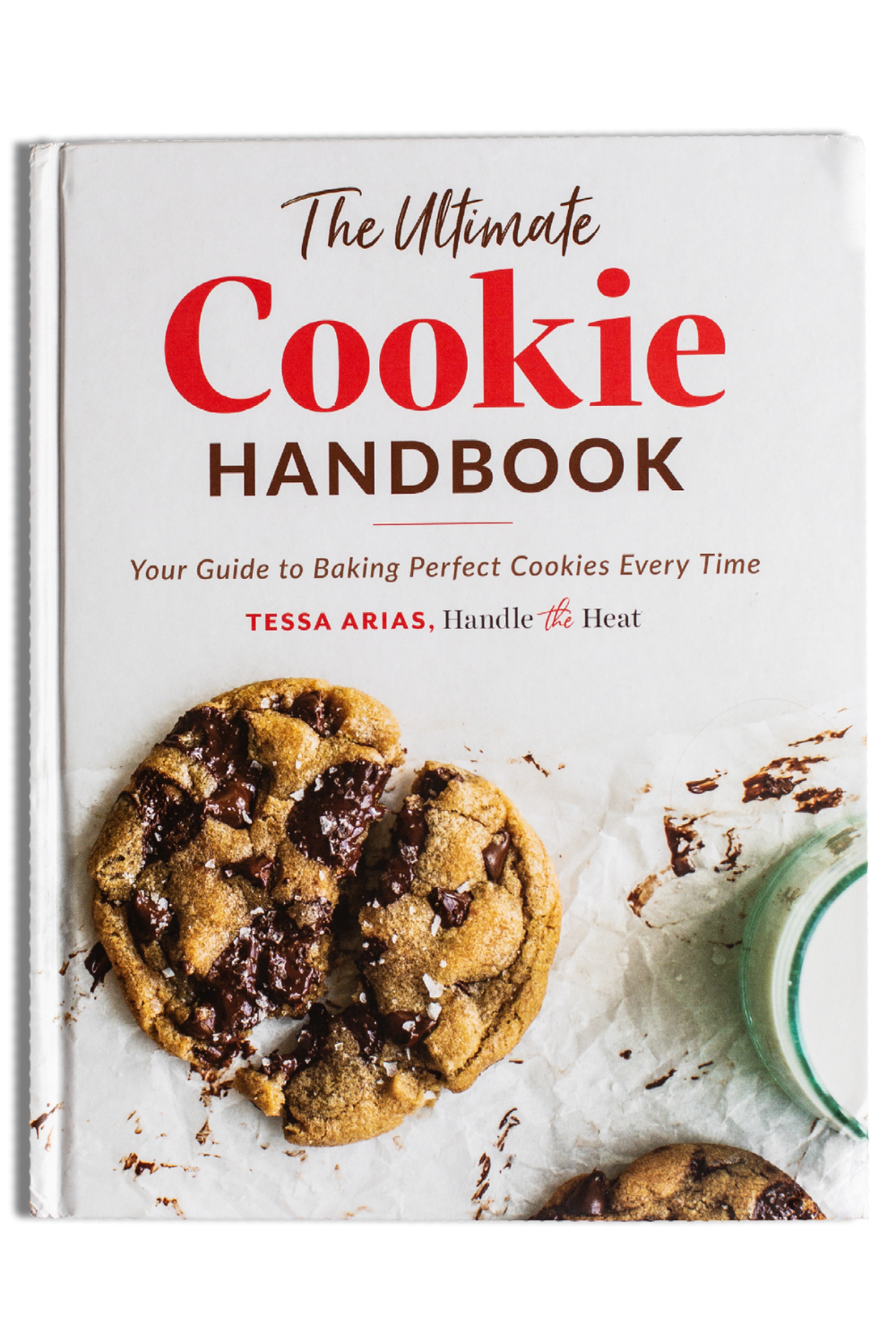
The Ultimate Cookie Handbook
Learn the sweet SCIENCE of cookie baking in a fun, visual way to customize your own recipes frustration-free. Plus, my best 50+ homemade cookies!
This post was originally published in 2017 and updated with recipe improvements, updated tips, and new photos. Photos by Ashley McLaughlin.
HTH Community Pies
Take a look at these pies using this recipe, all made by HTH community members – many of whom had previously struggled to master pie dough! Follow the tips in this article to bake pies that look like these:
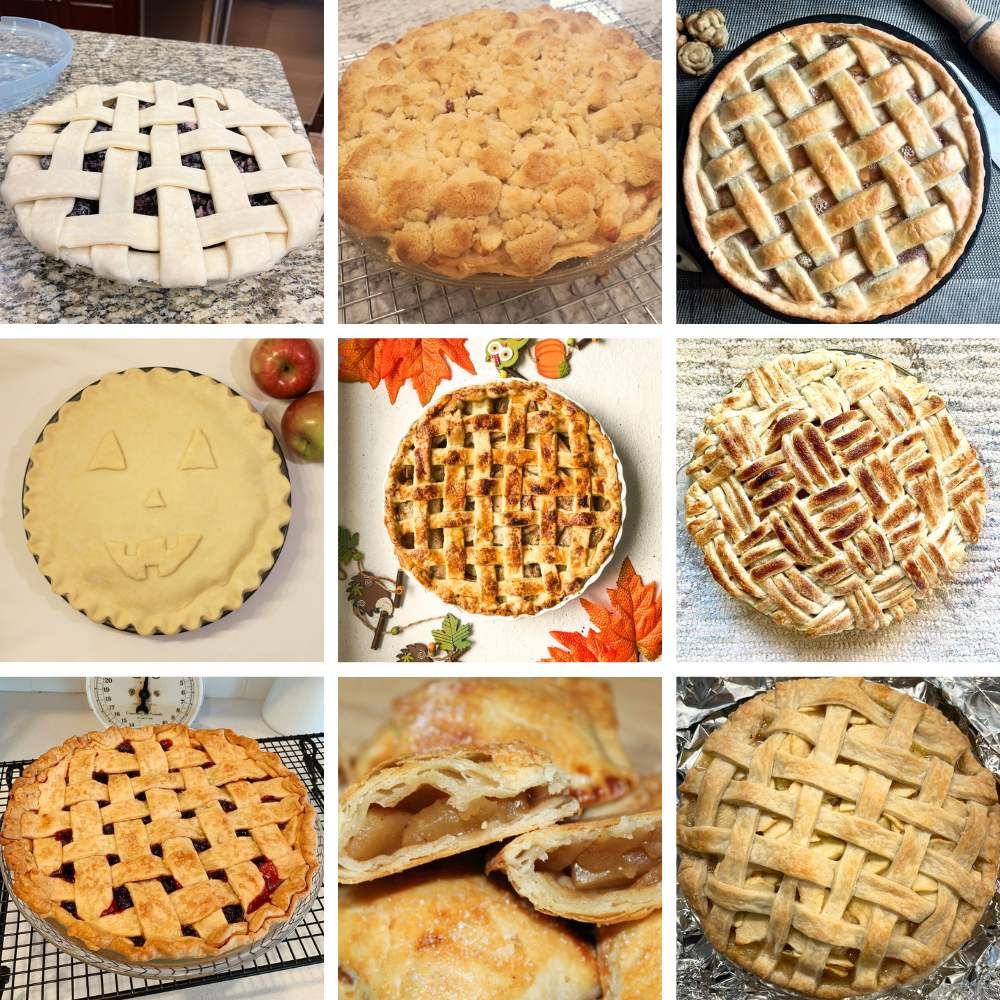
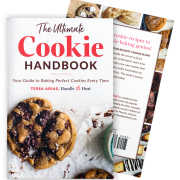
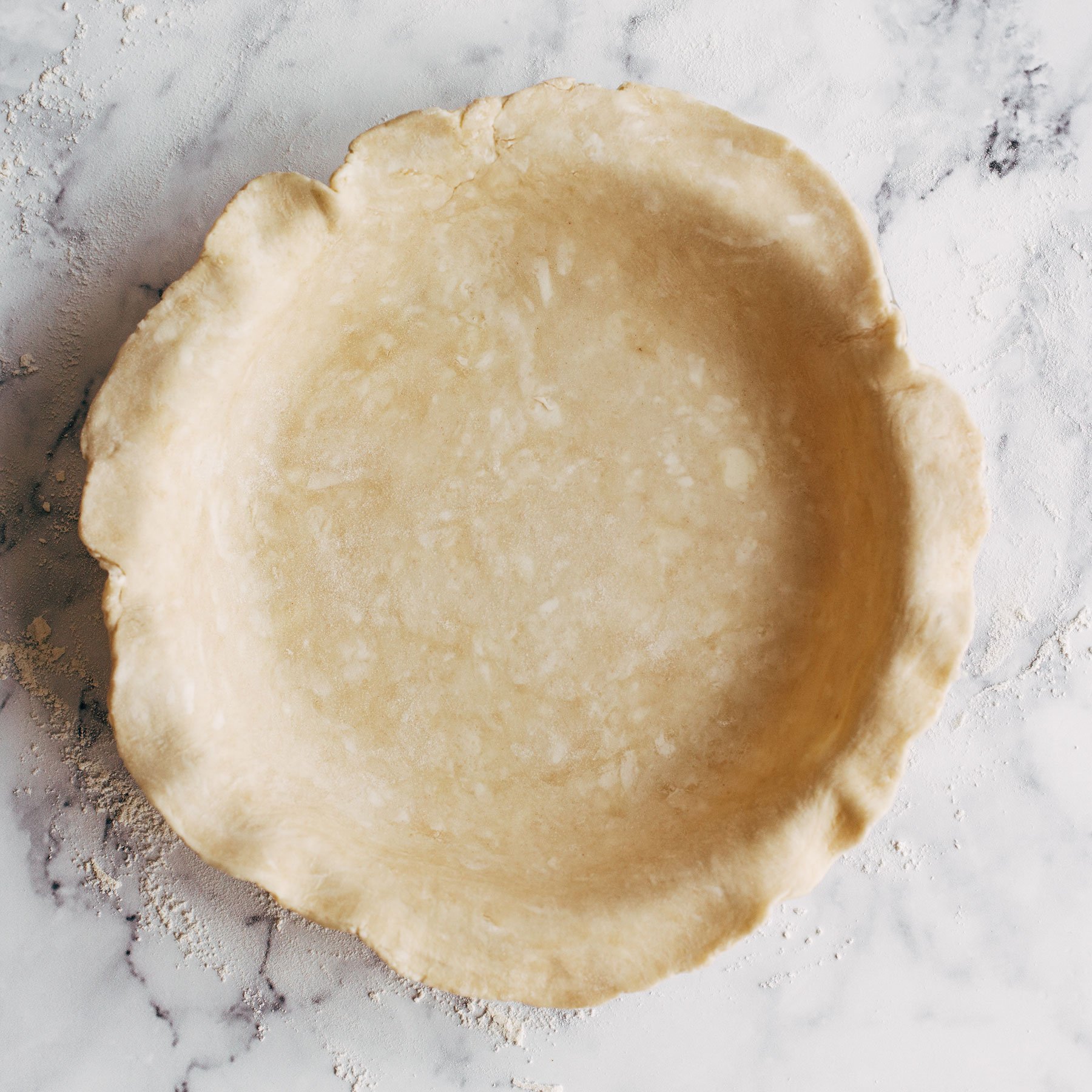


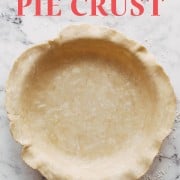
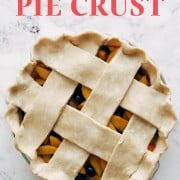
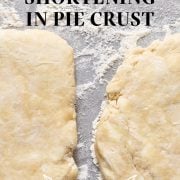
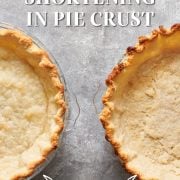
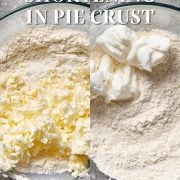
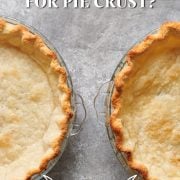
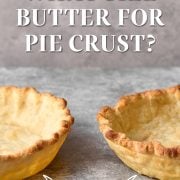
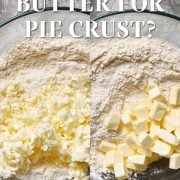

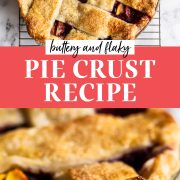

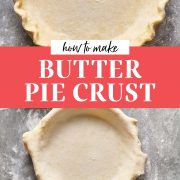
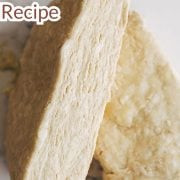




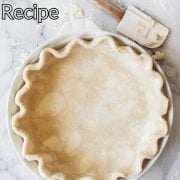
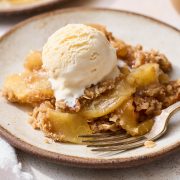
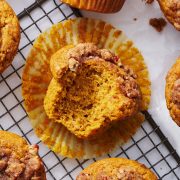
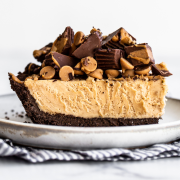

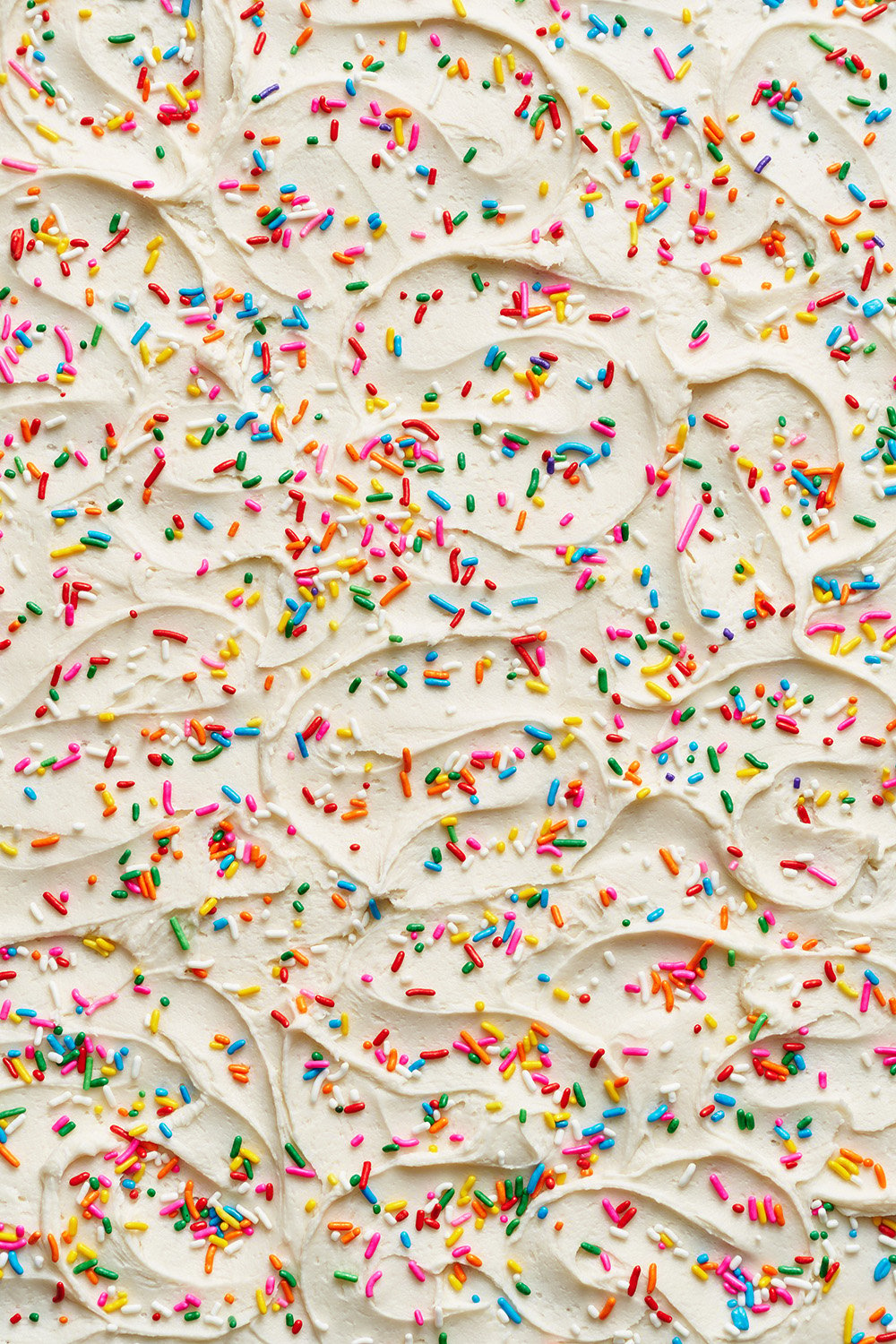
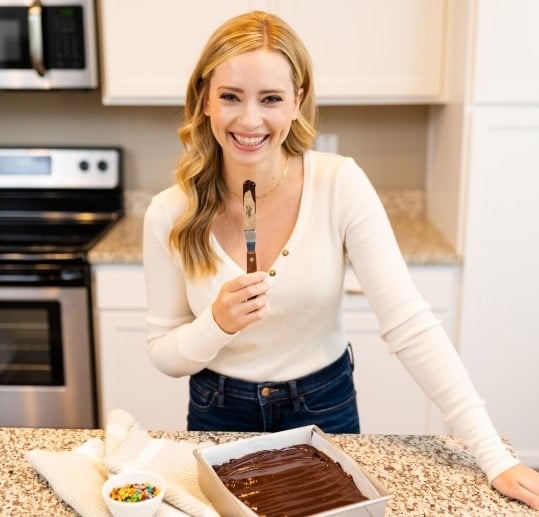

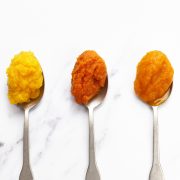
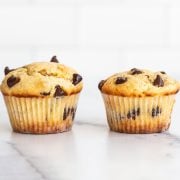
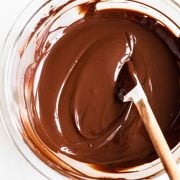









This was so easy to do and roll out. And it was so flaky and baked up lovely. I made the apple caramel pie and this crust held up! No soggy bottom. Will make it again and again and again…
Yay!! No soggy bottom’s wanted here! Apple caramel pie sounds fantastic! I’m so happy to hear you loved this recipe, thanks for the rave review!
Love this recipe,, Nice and flaky..
Love this pie crust.. I used my food processor to shred the frozen butter. It made incorporating the flour n butter so much easier.. Thank you.
This was a very easy pie crust to make. Which means, more pie crusts in the future!
That’s a huge win in our book! Yay!!
A very easy pie crust. I have been unsuccessful in the past with homemade pie crusts. This was easy to follow and I can’t wait to taste.
So wonderful to hear you loved this recipe, Karie! Glad that the recipe was easy to follow!
Ok, everyone says their pie crust is “the best.” No, no. THIS ONE IS THE BEST. It’s flaky and perfect. Print this and save! Period. End of story. #
Buttery, flakey and so delicious! I loved the step by step instructions that made it fool proof. Pie crust has always been a struggle for me but this recipe and the instructions made it simple, easy and the result was perfection!
Yay!! So happy to hear of your success with this recipe, Tiffany! Thanks so much for sharing! 🙂
Thank you so much for this great pie crust recipe – I finally have had success making pie crust using these ratios! It has always been tricky for me, but all of your tips really helped!
Hooray!! So happy to hear that, Veronica!
One of the best pies I’ve ever made. The crust cooked beautifully and was flakey. All of Tessa’s adjustments to her original recipe were spot on. I used an aluminum pan rather than my usual stoneware pan because I wanted a crispier bottom. I will definitely rely on this recipe when I make my thanksgiving pies.
Wonderful to hear! So glad you love this new-and-improved recipe, Wendy 🙂 Be sure to tag Handle the Heat on social media so we can see your gorgeous Thanksgiving pies!
I have tried this crust twice now. It is fantastic and so flavorful. It will become my only go to pie crust recipe.
Amazing!! So happy to hear that, Megan! Thanks for the rave review!
Quick and easy pie crust.
Absolutely fantastic! made both savoury and sweet pie and both turned out delicious with this dough!
Hooray!!